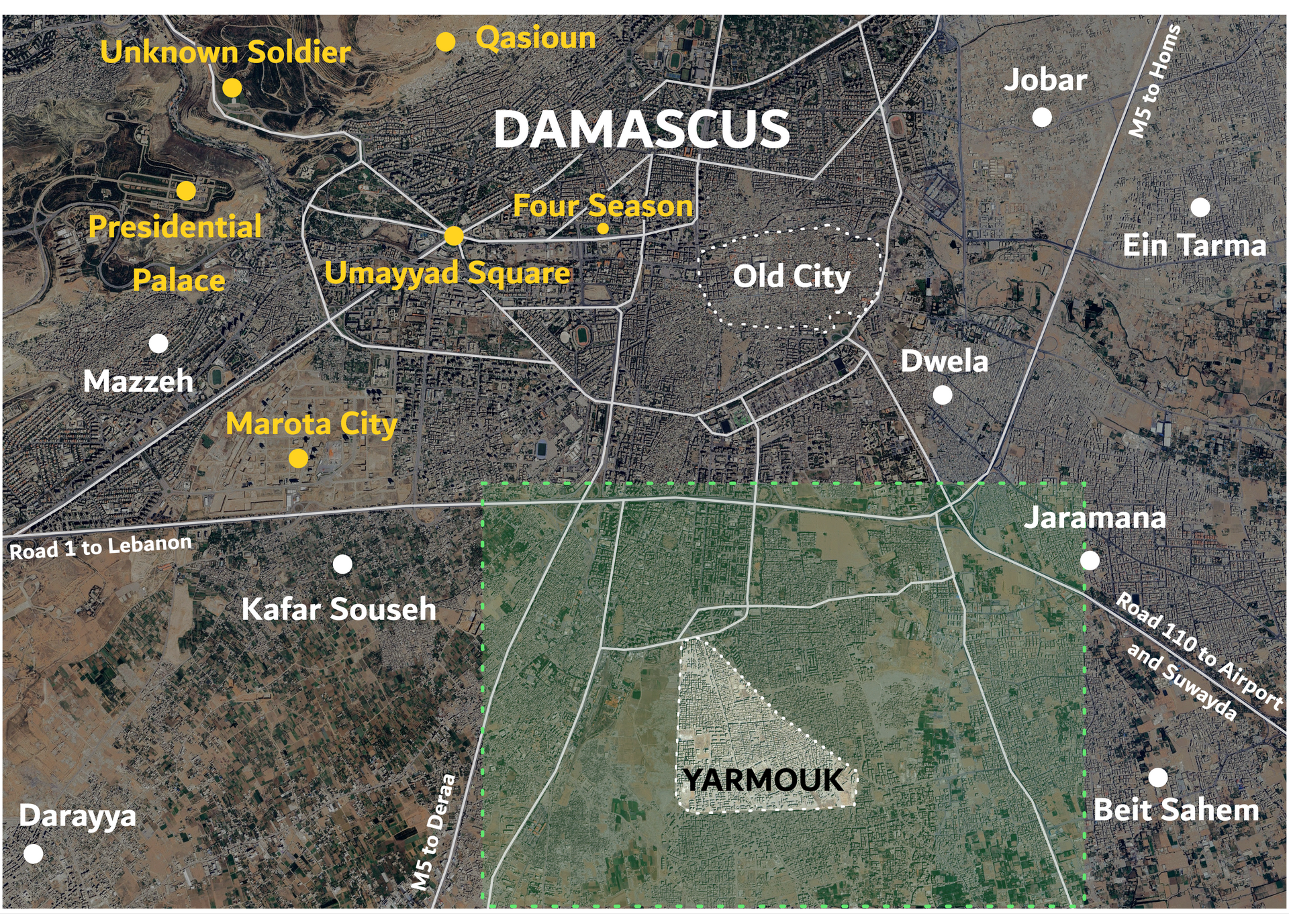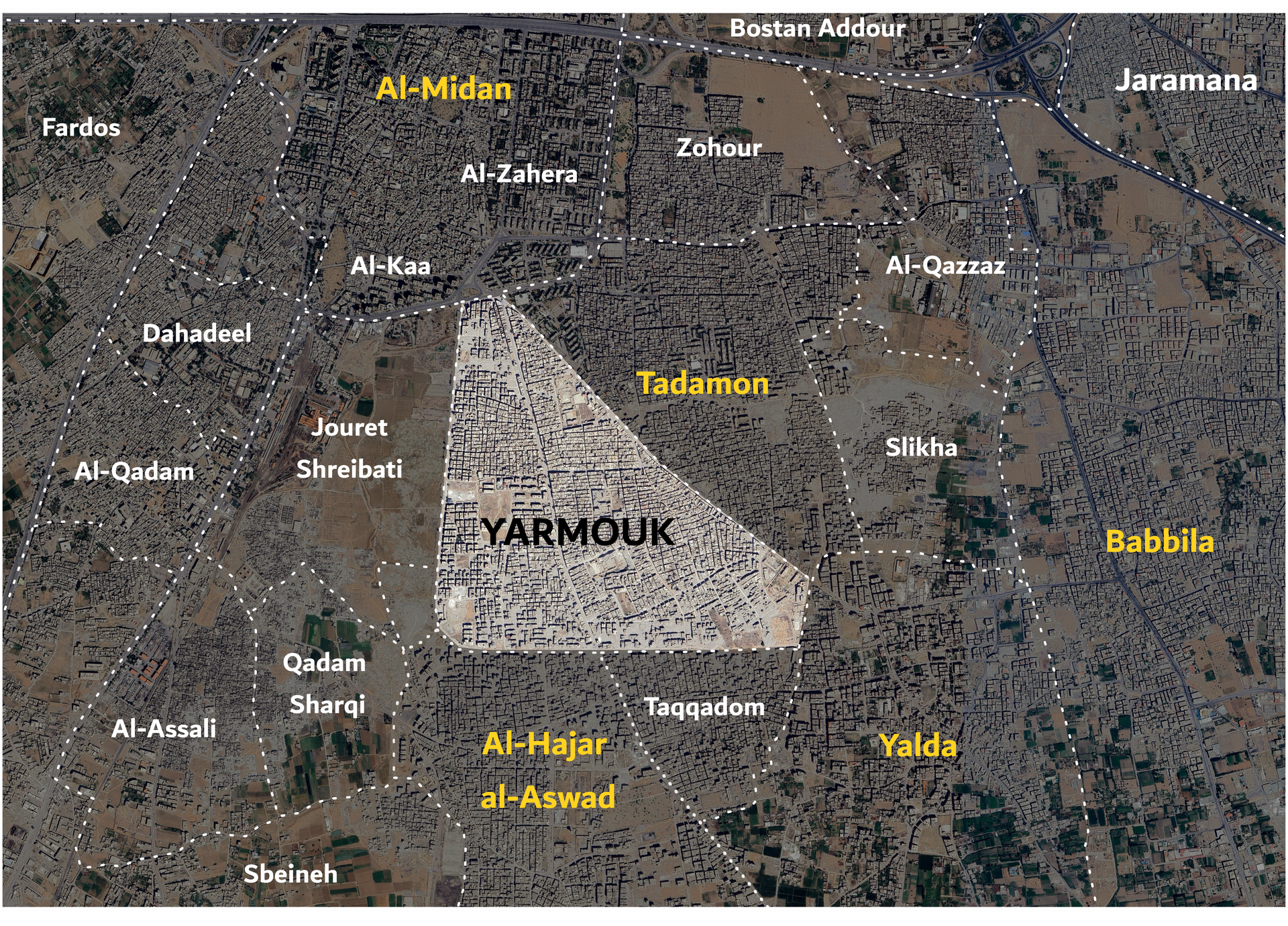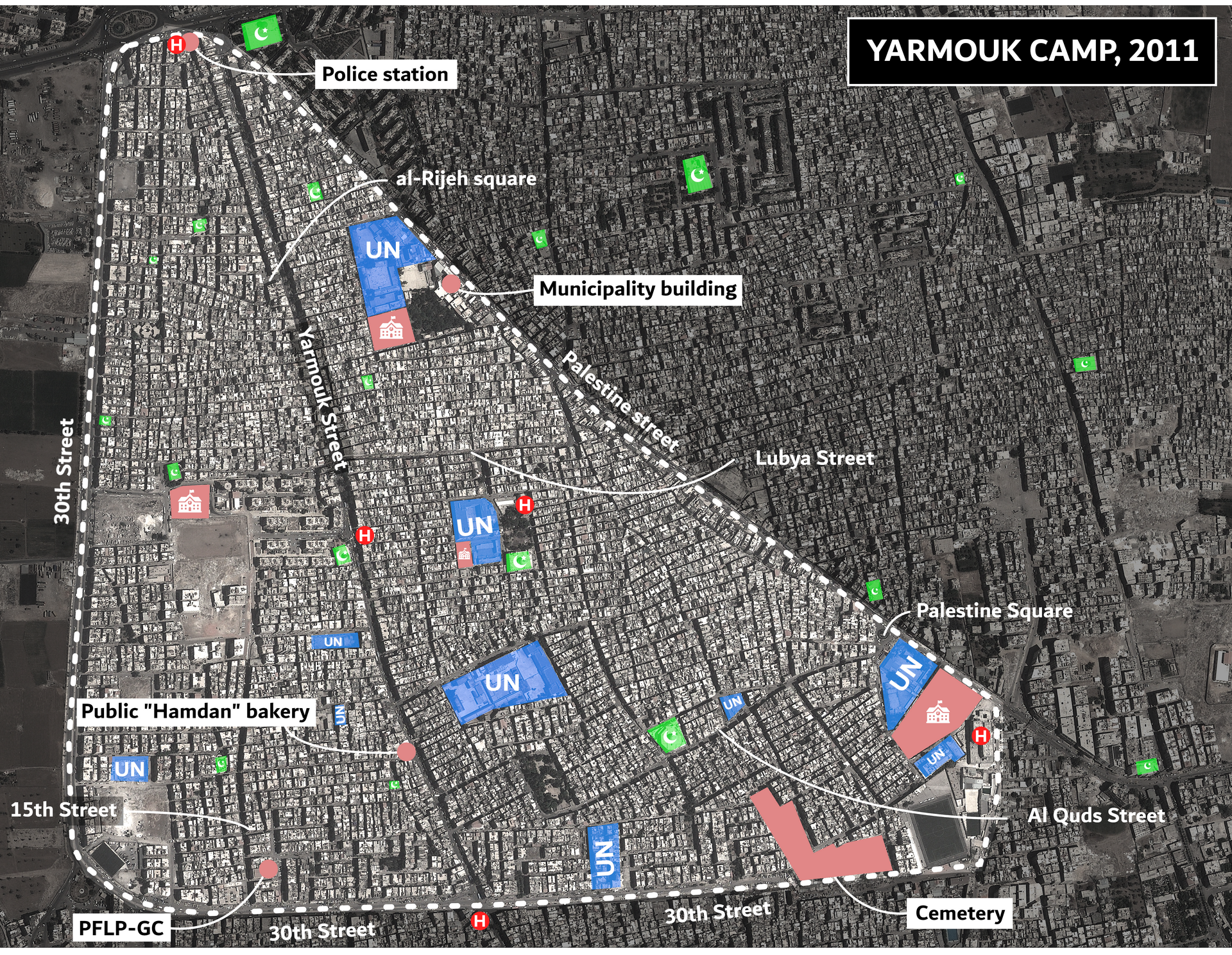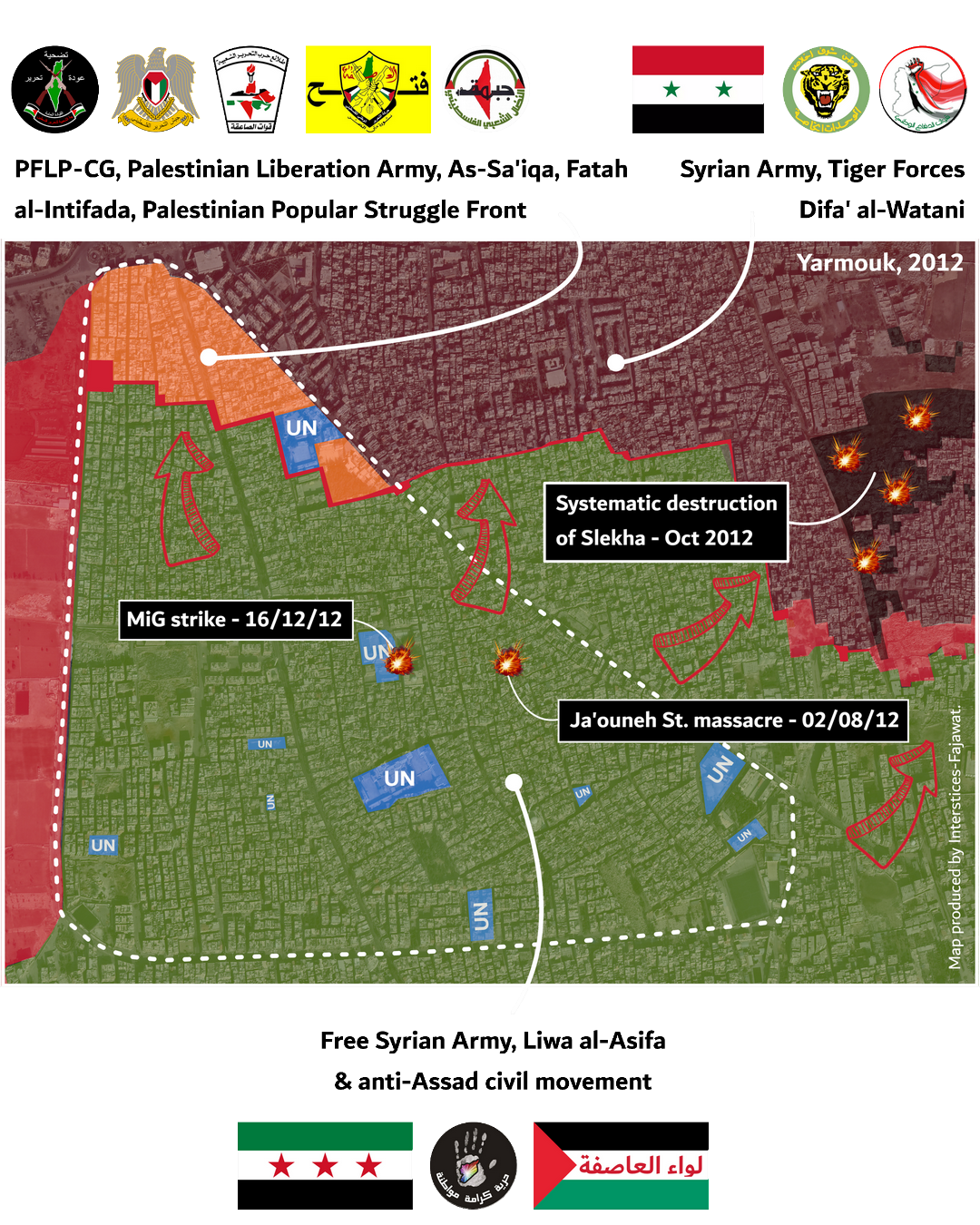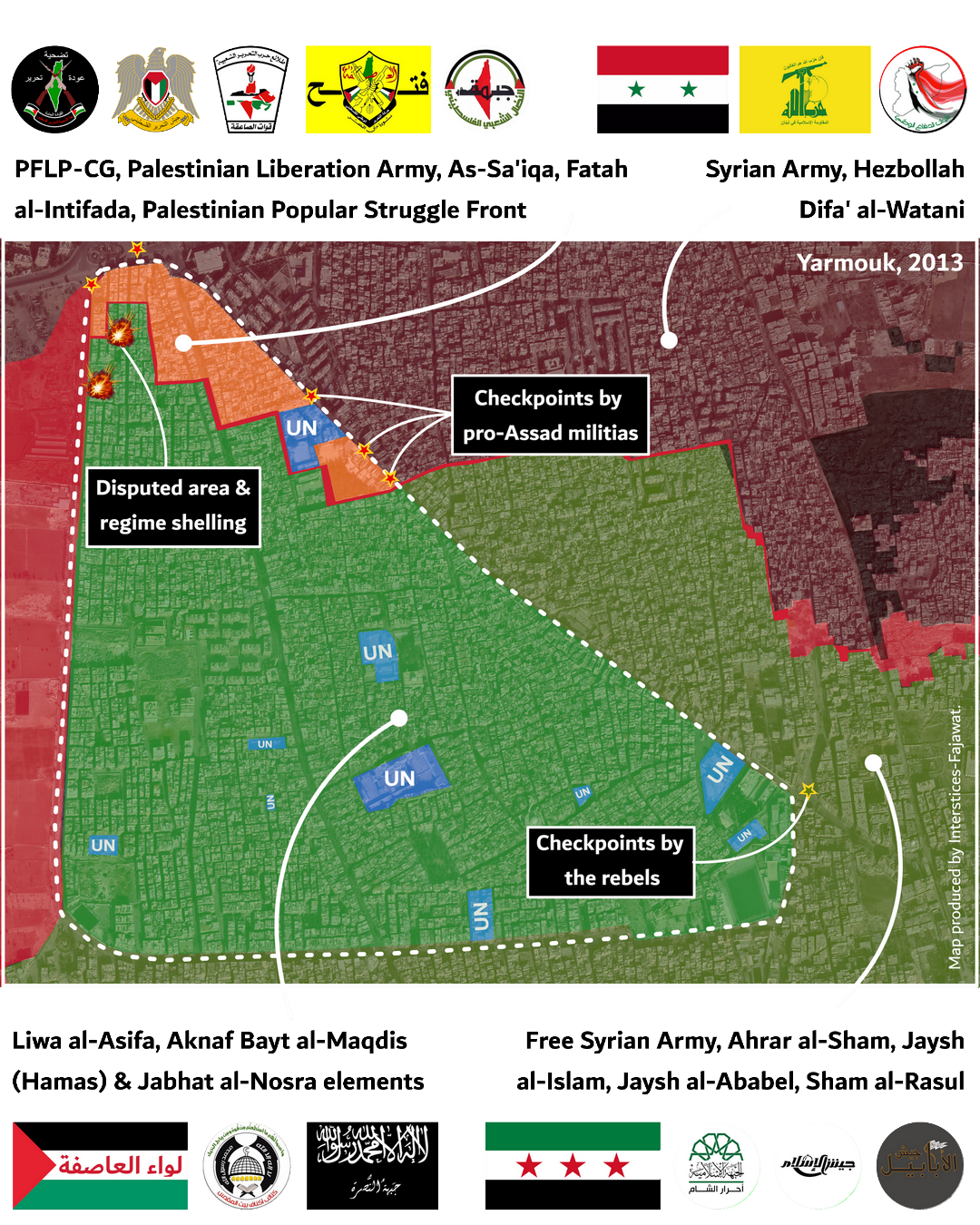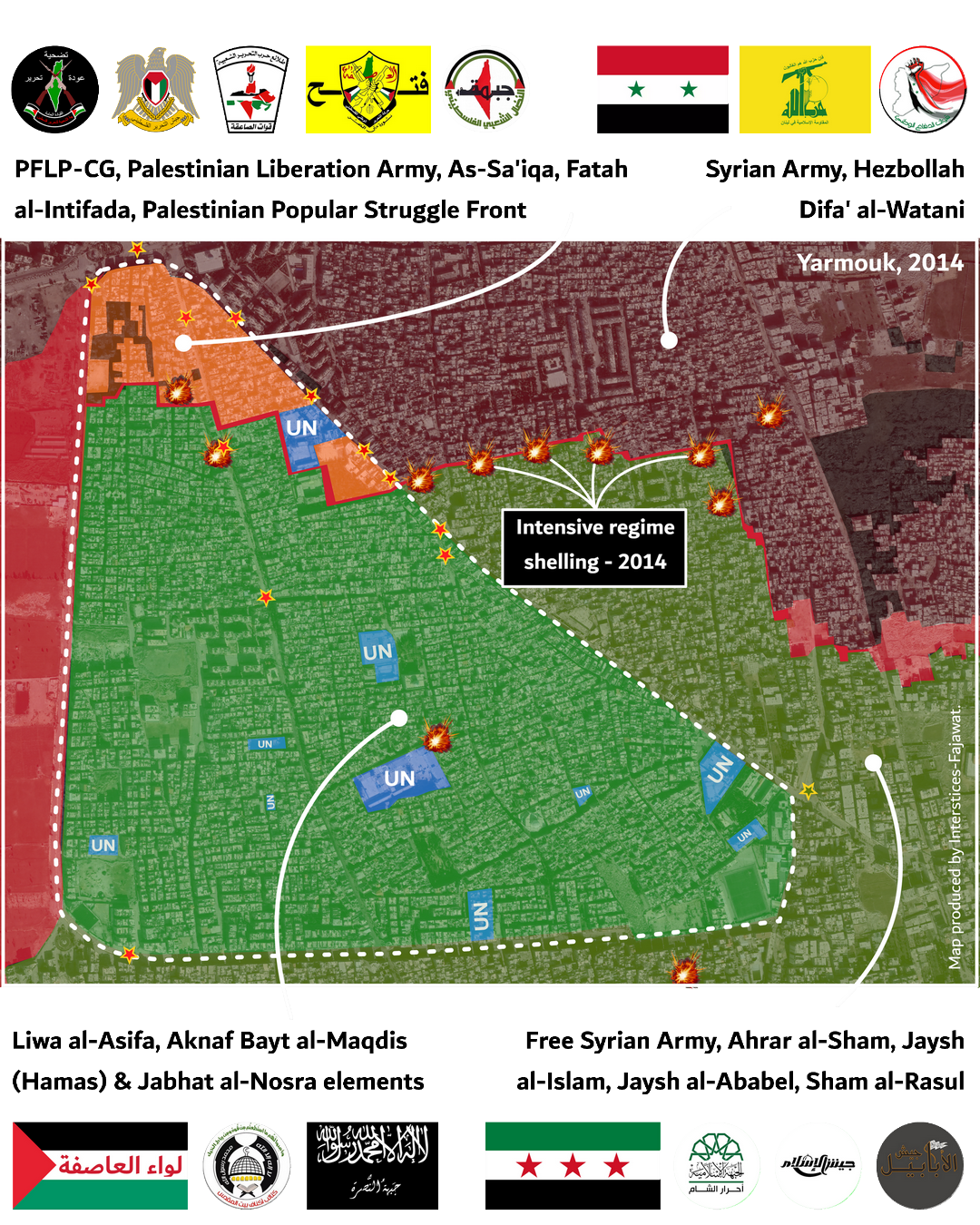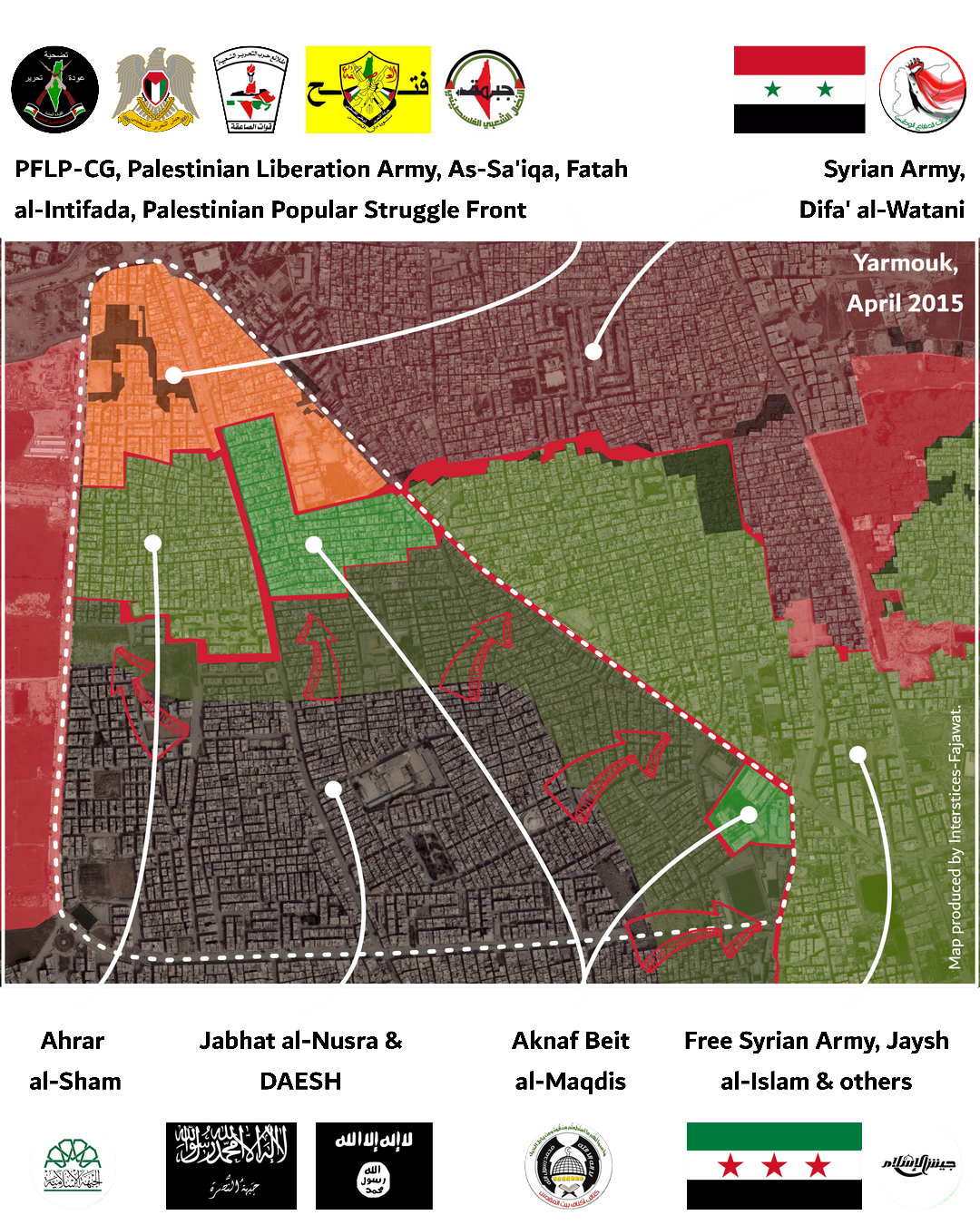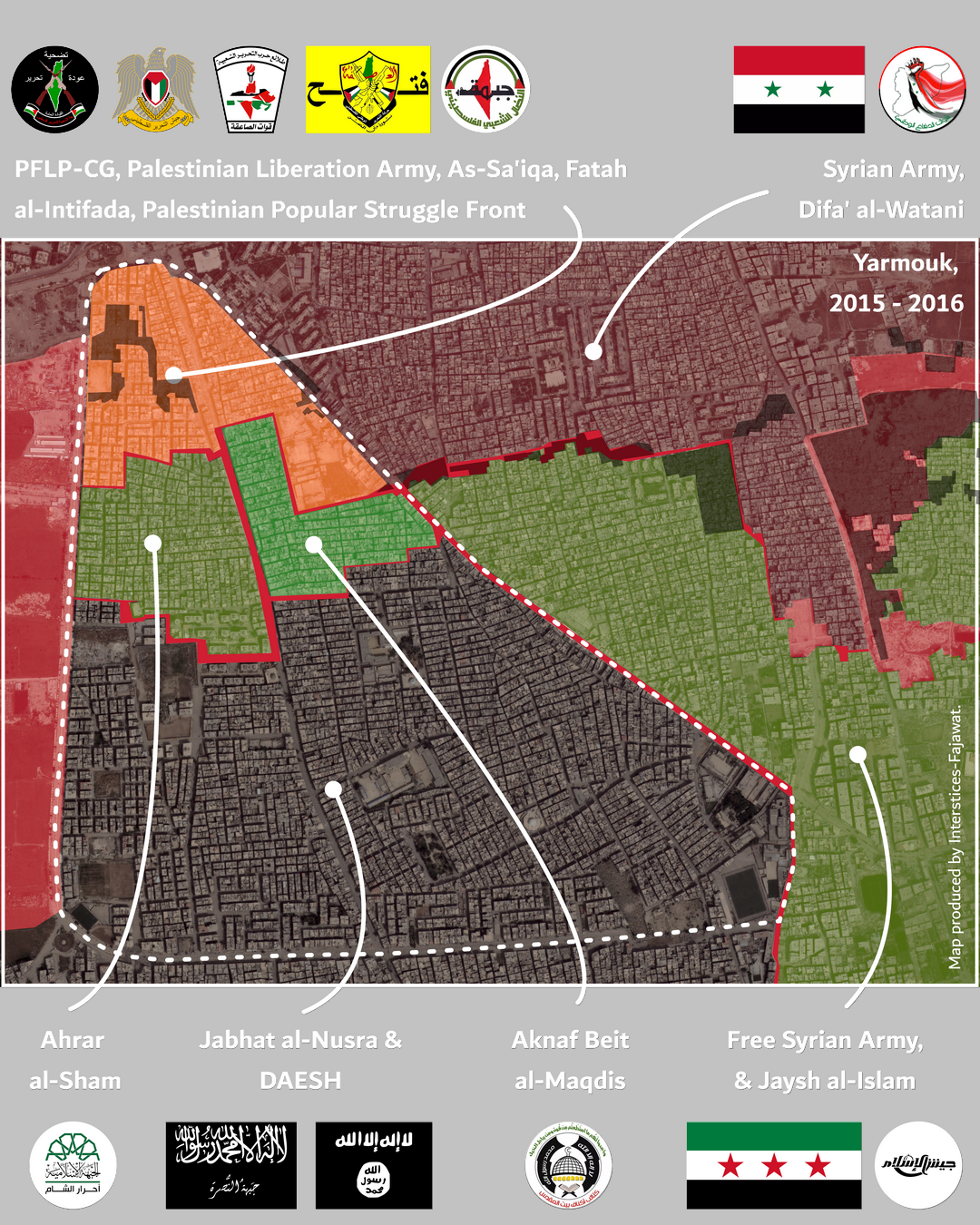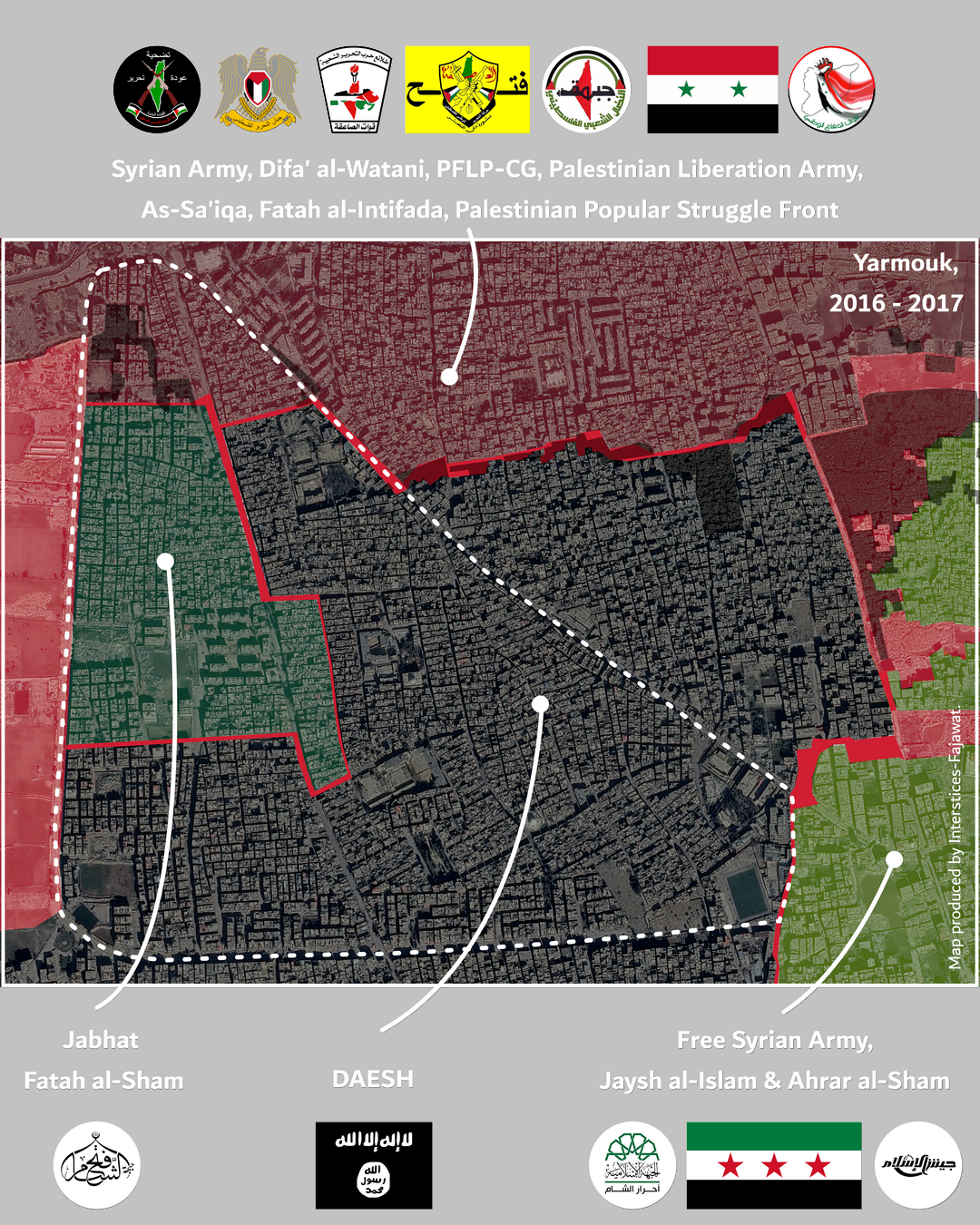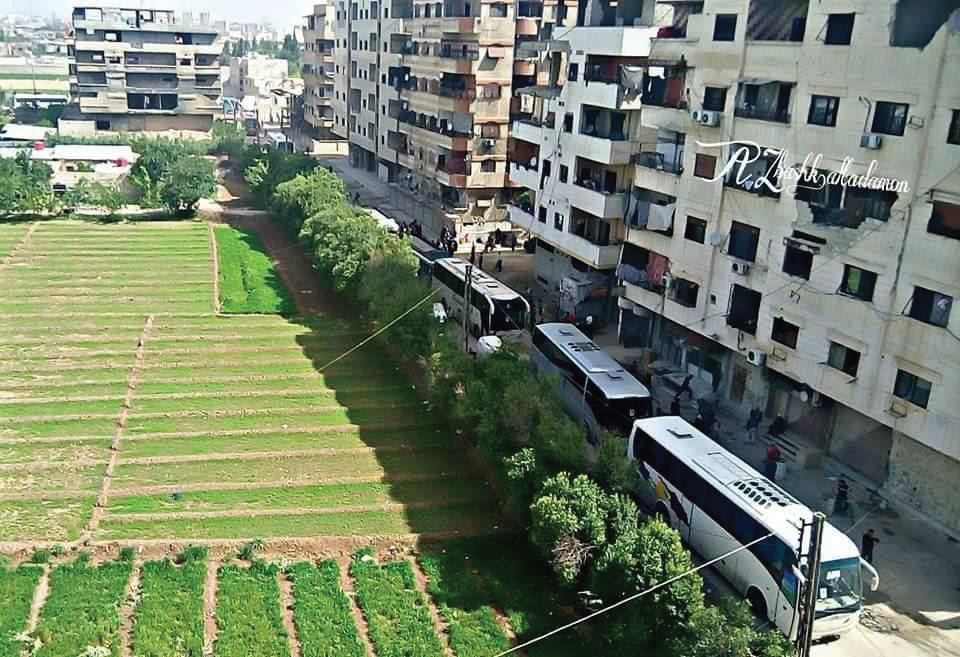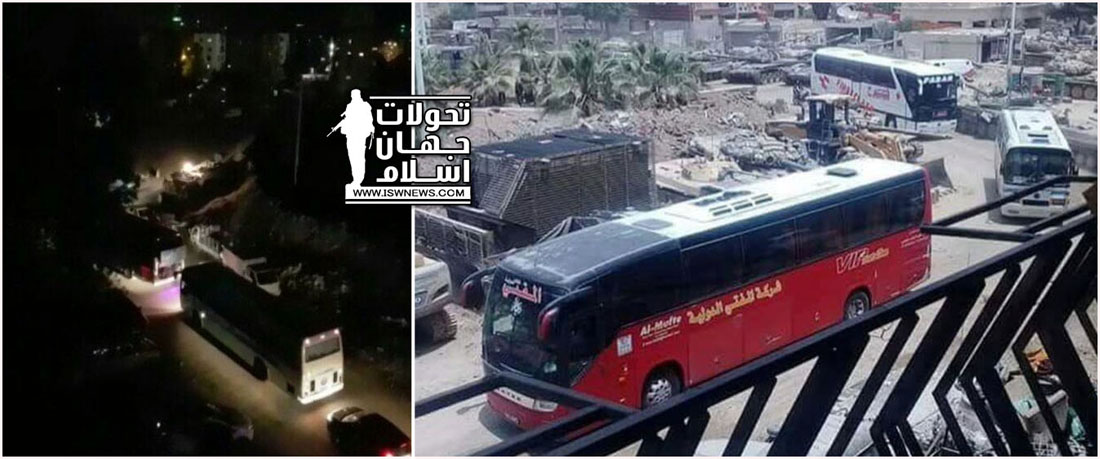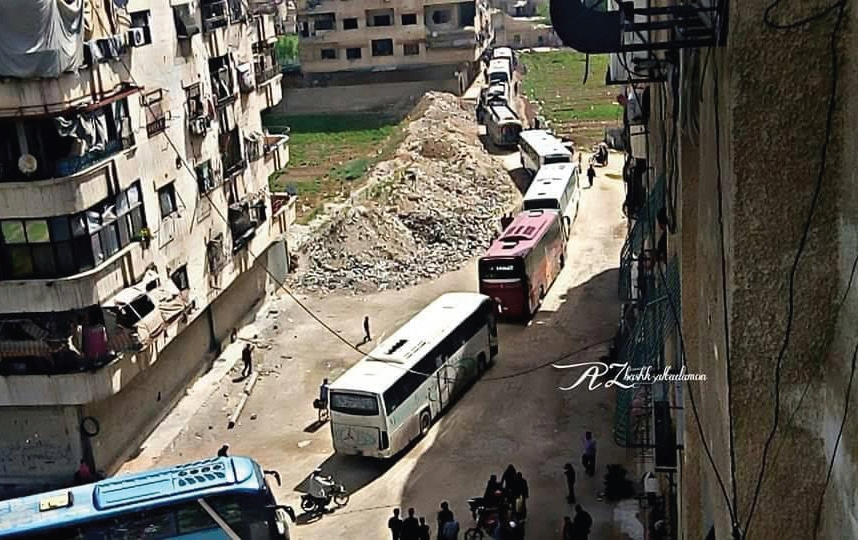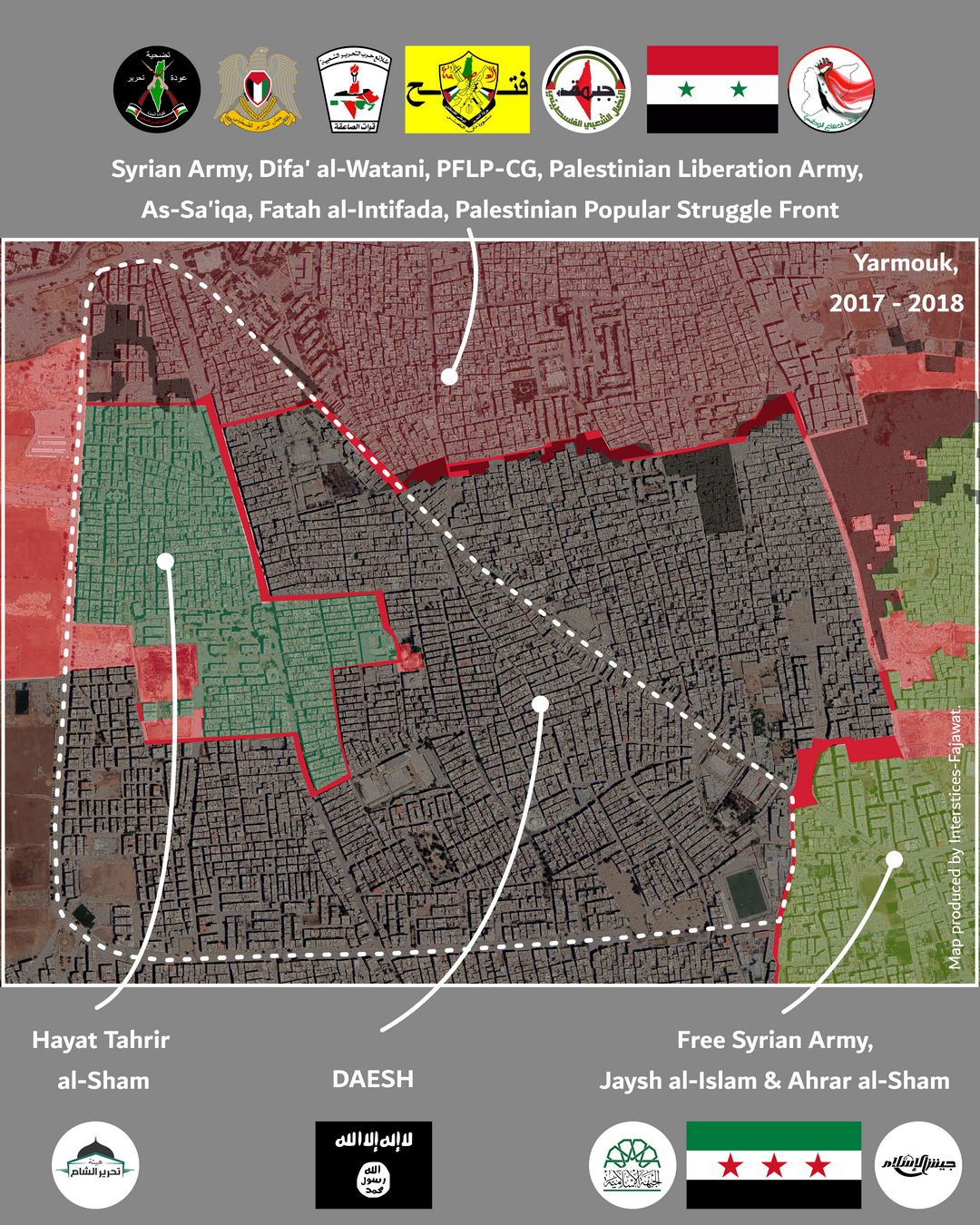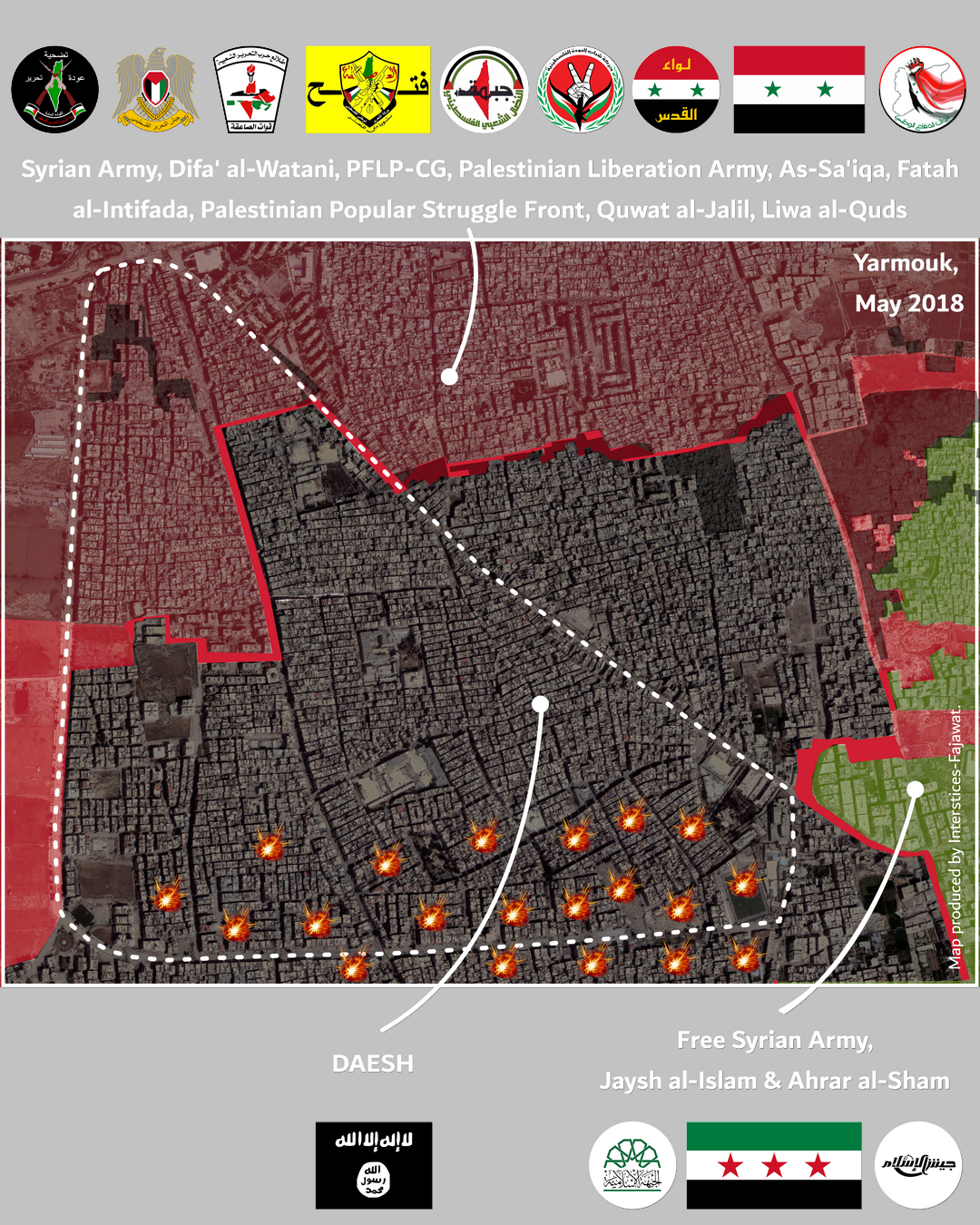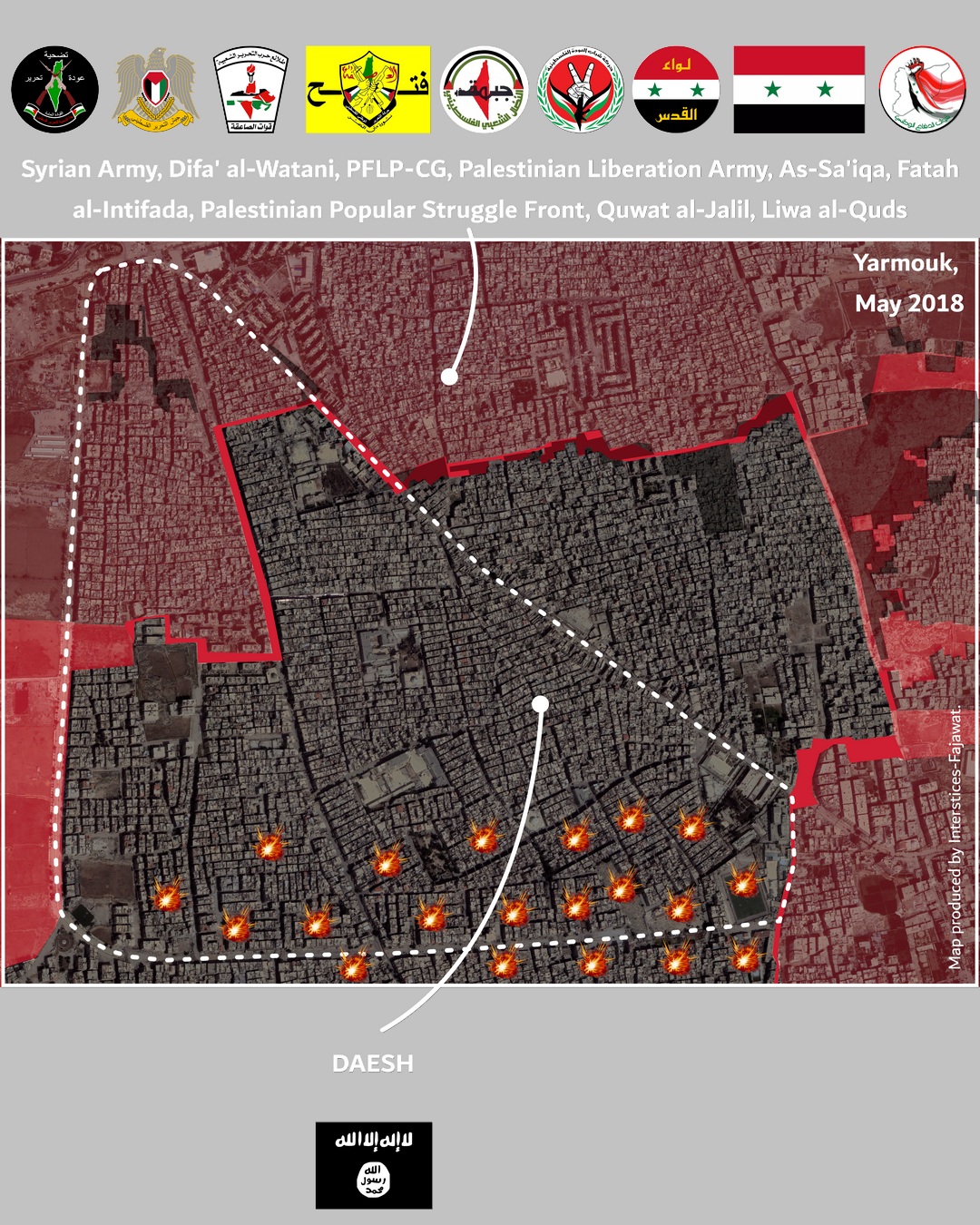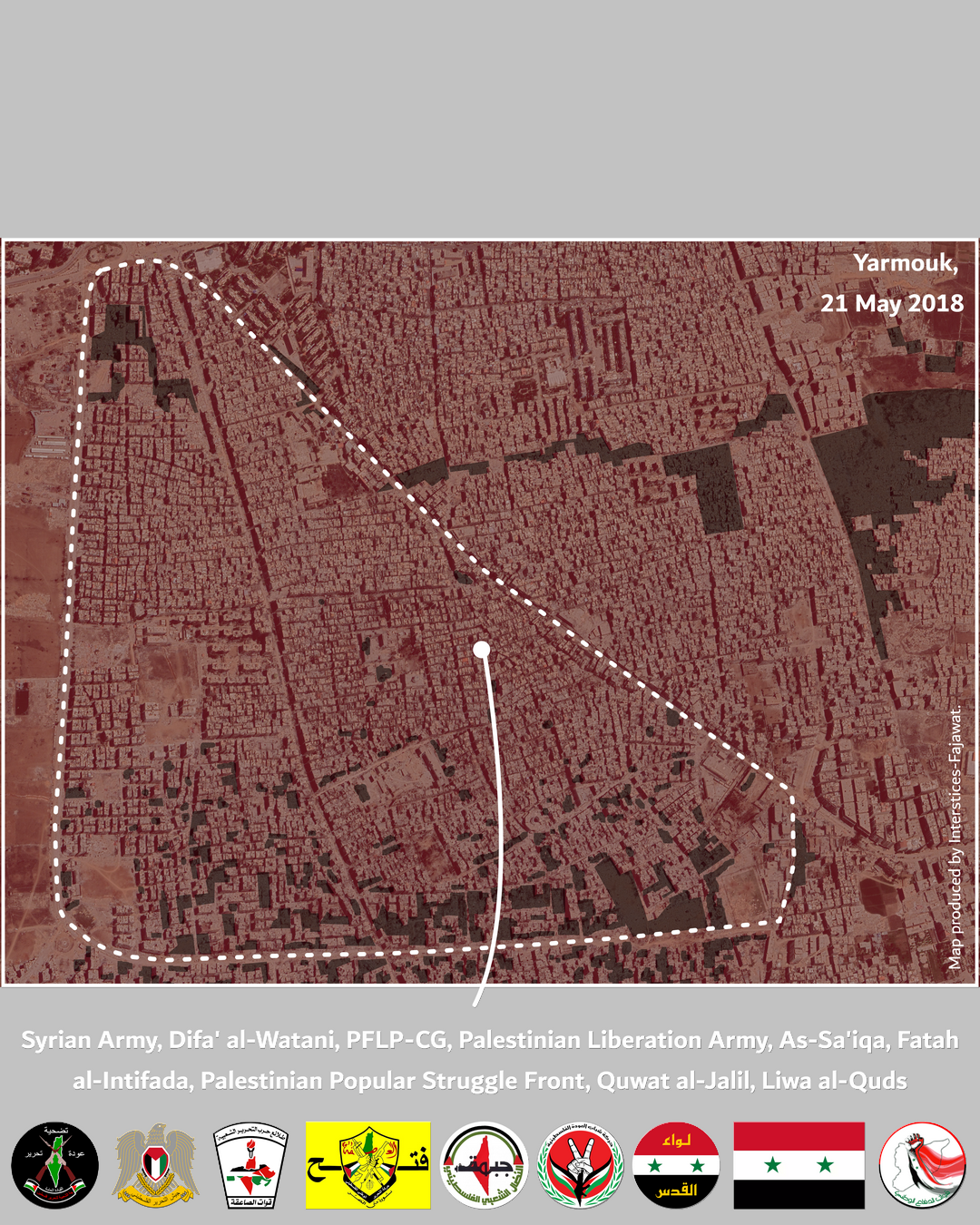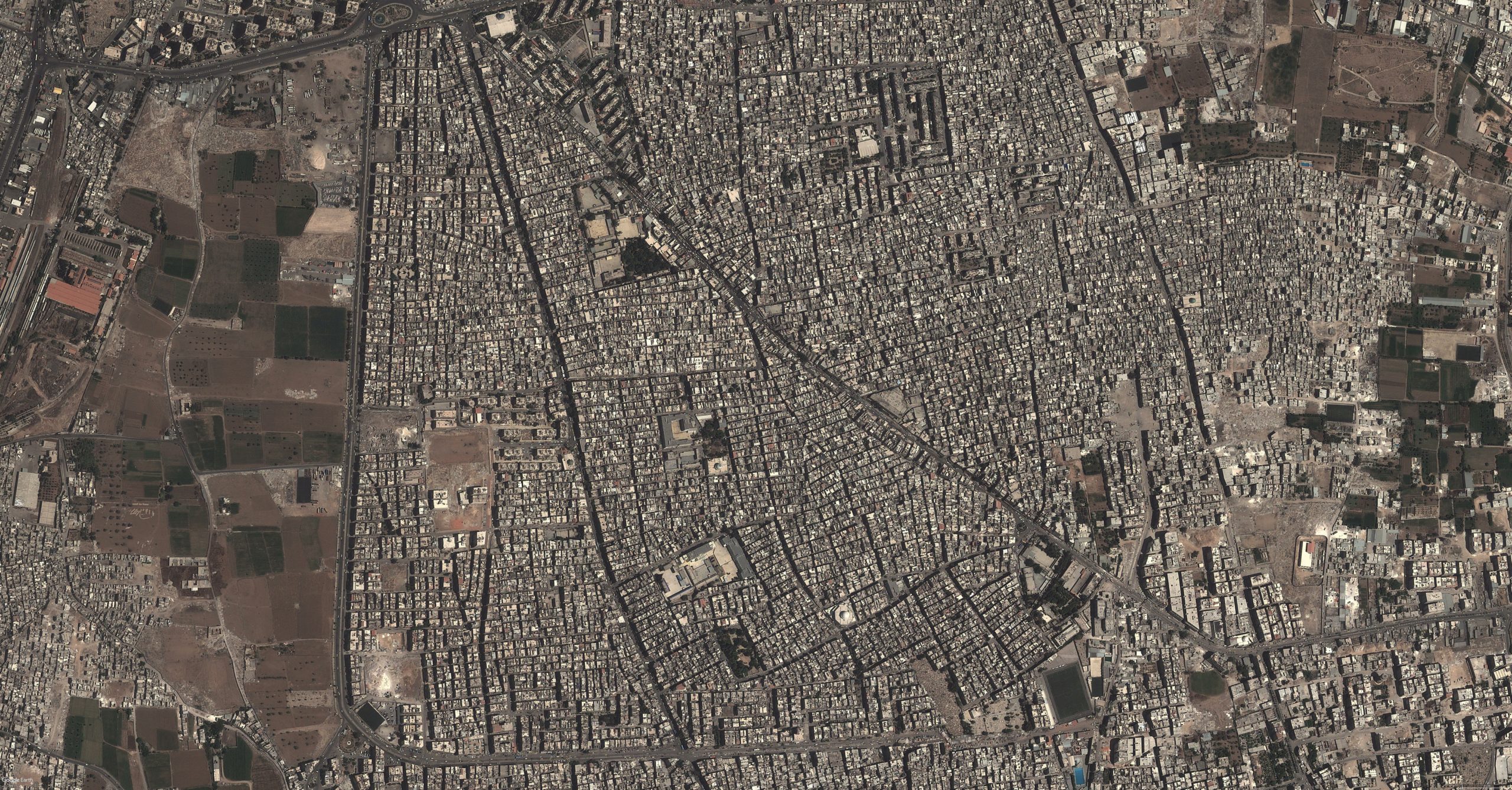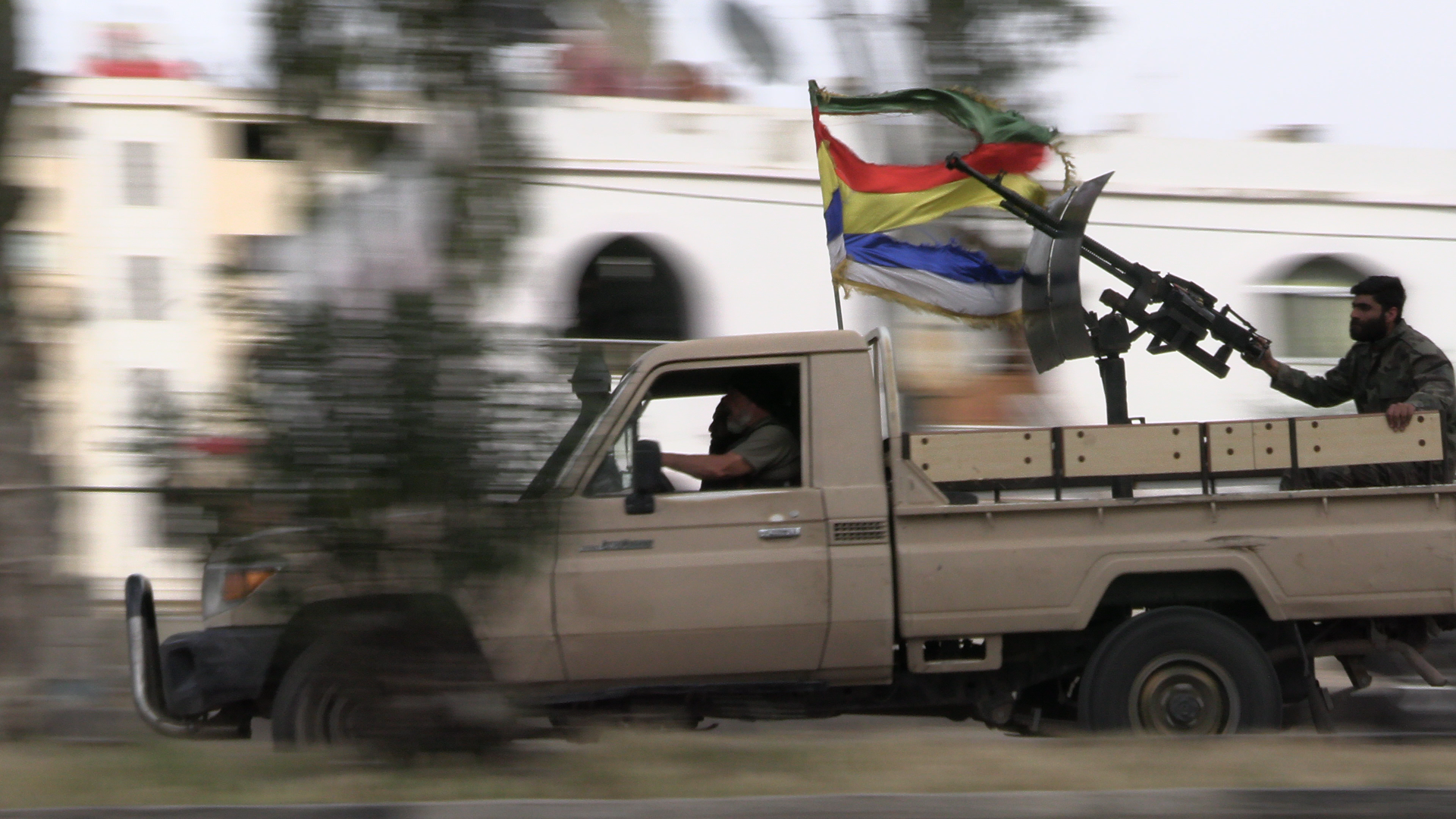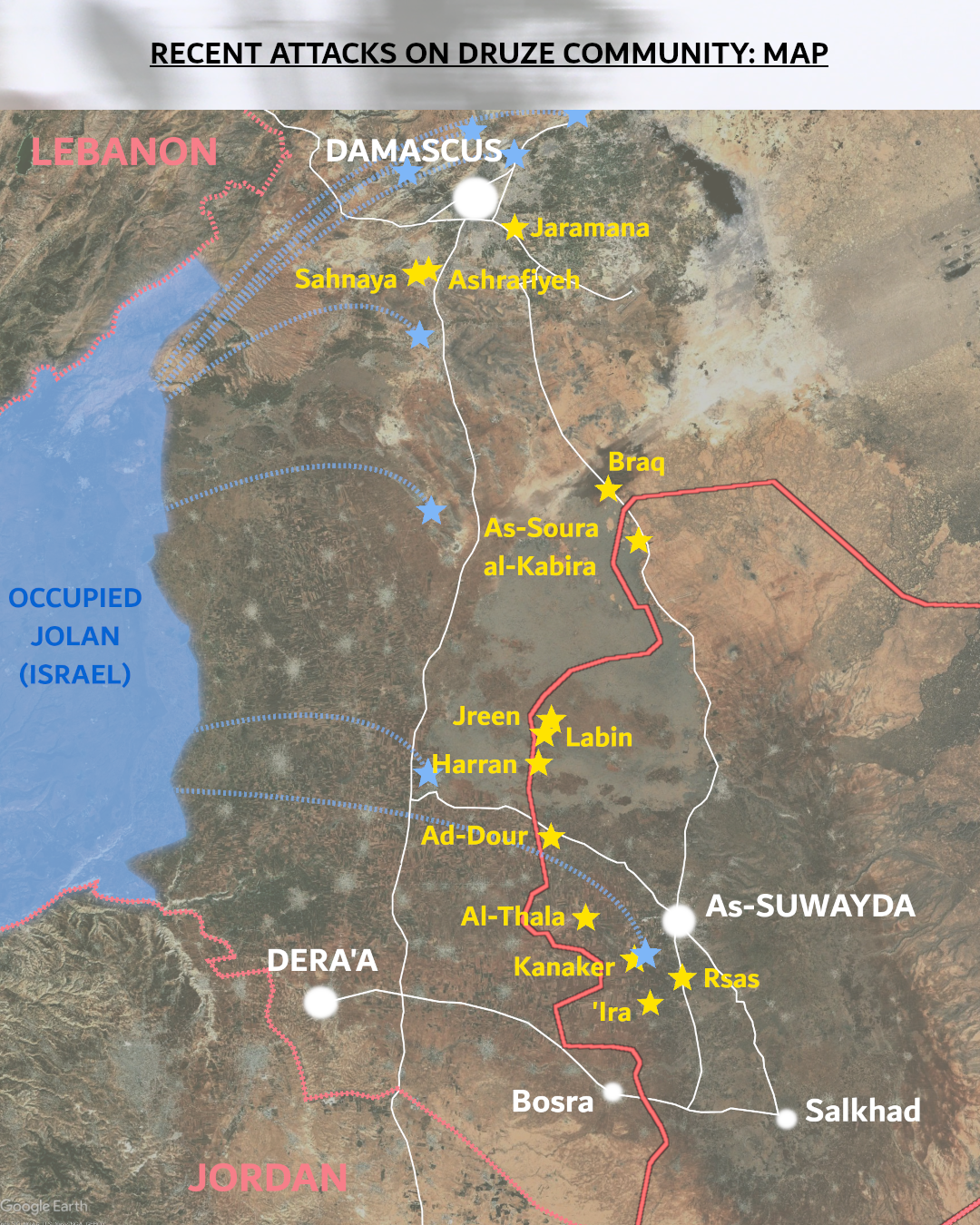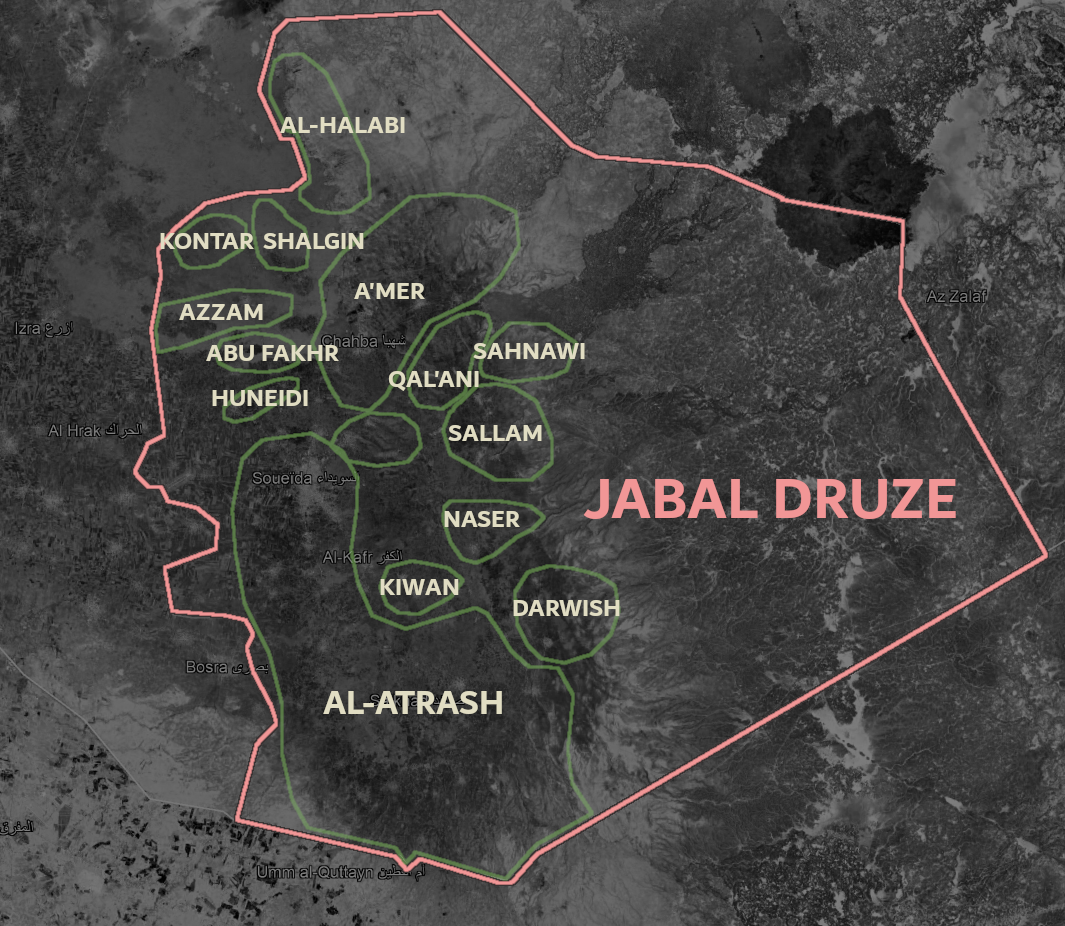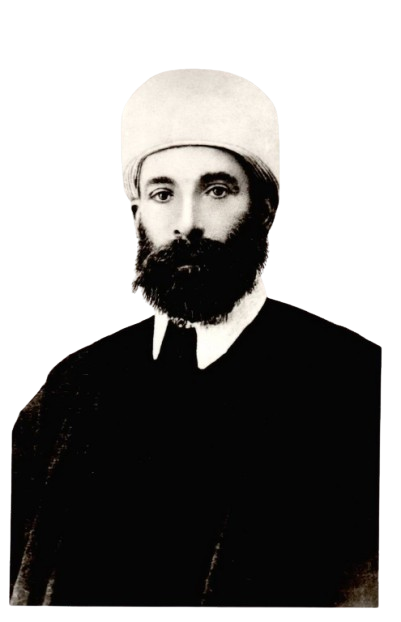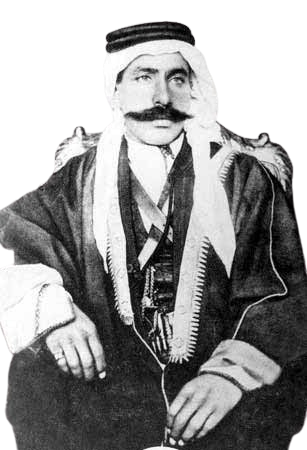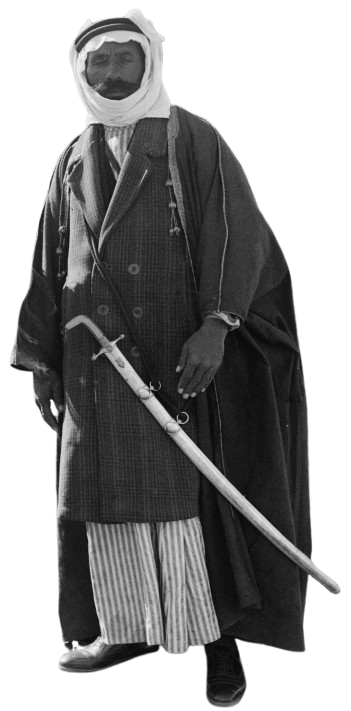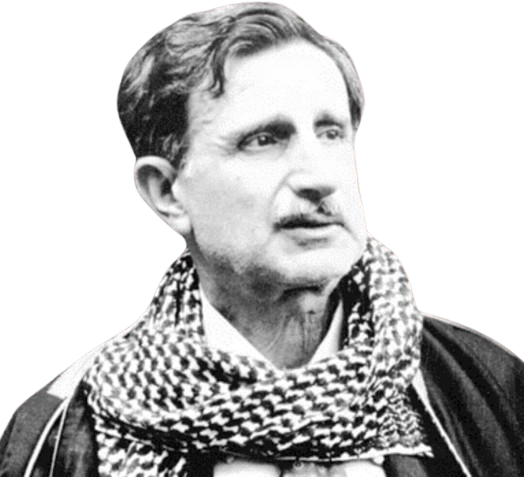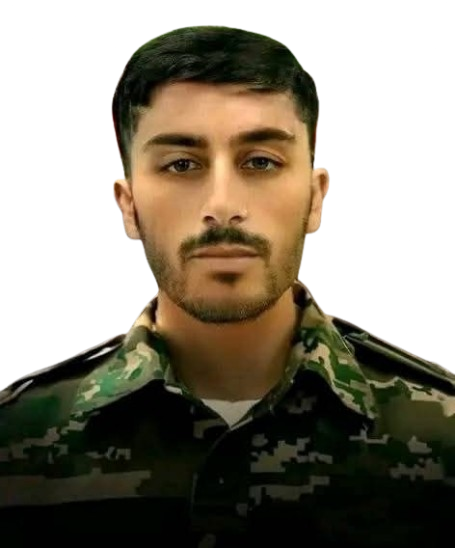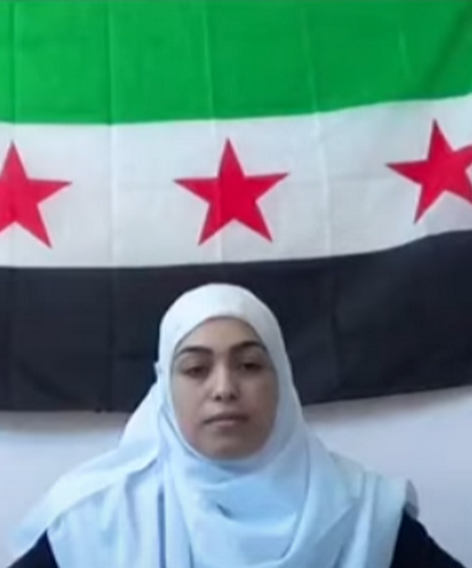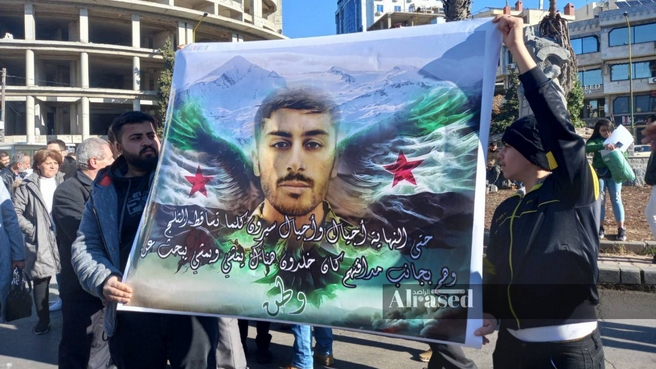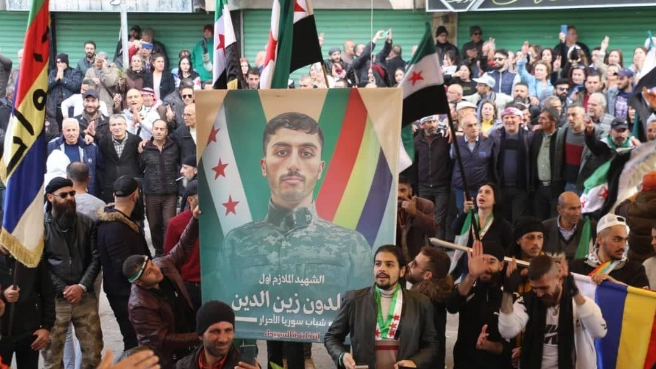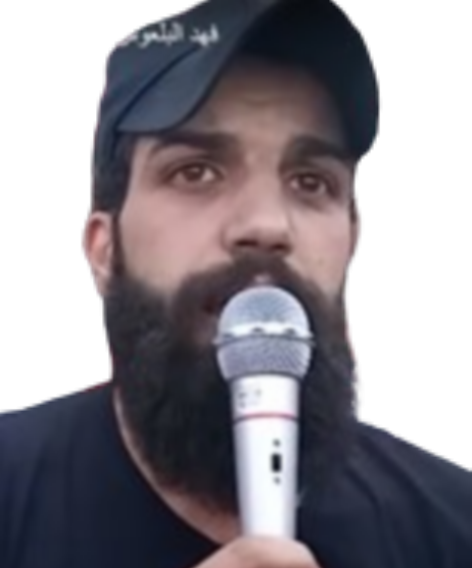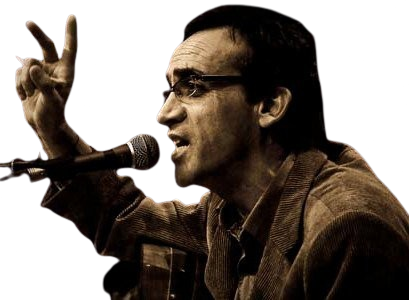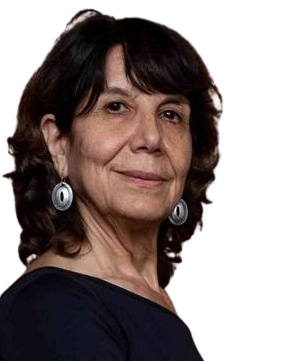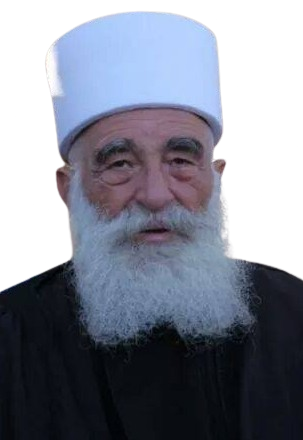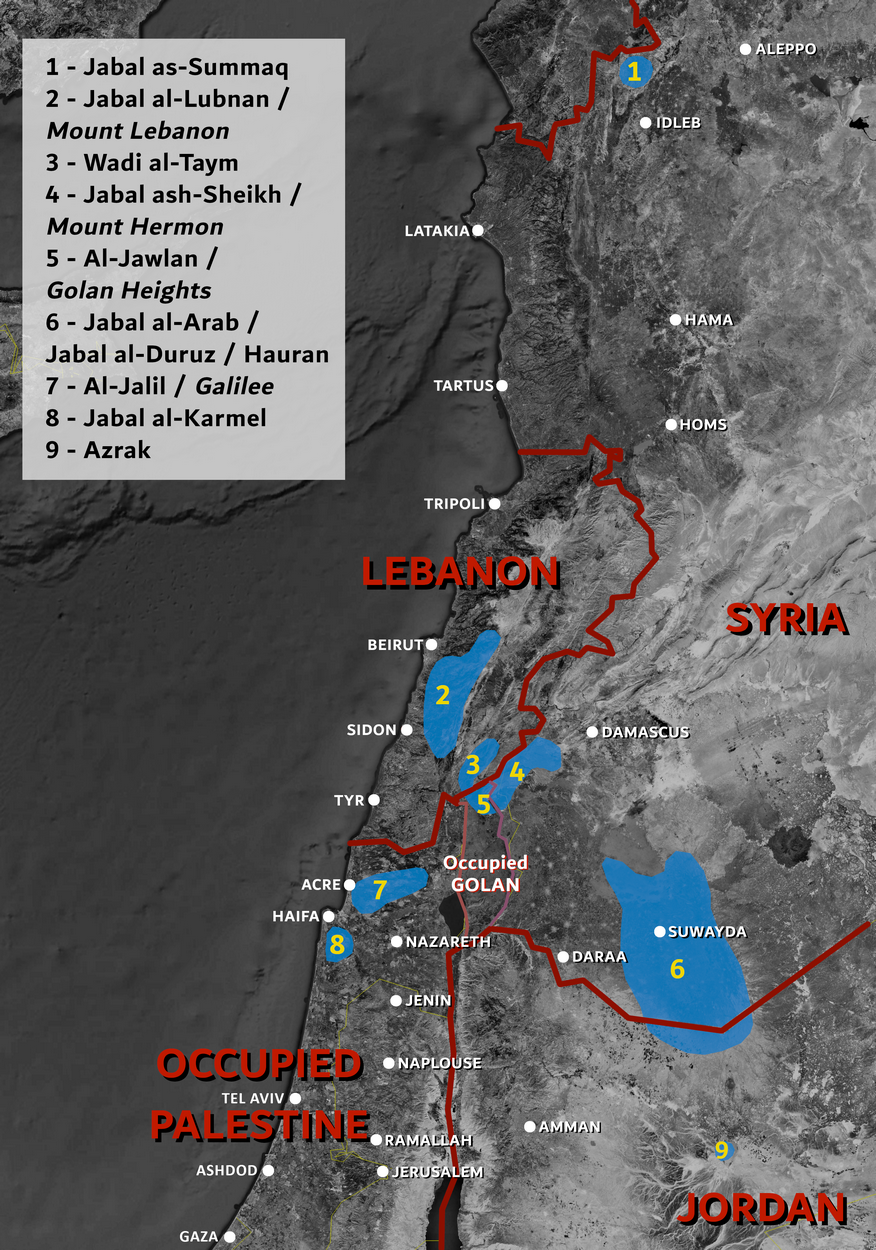Suwayda 2025: chronology of an predictable massacre
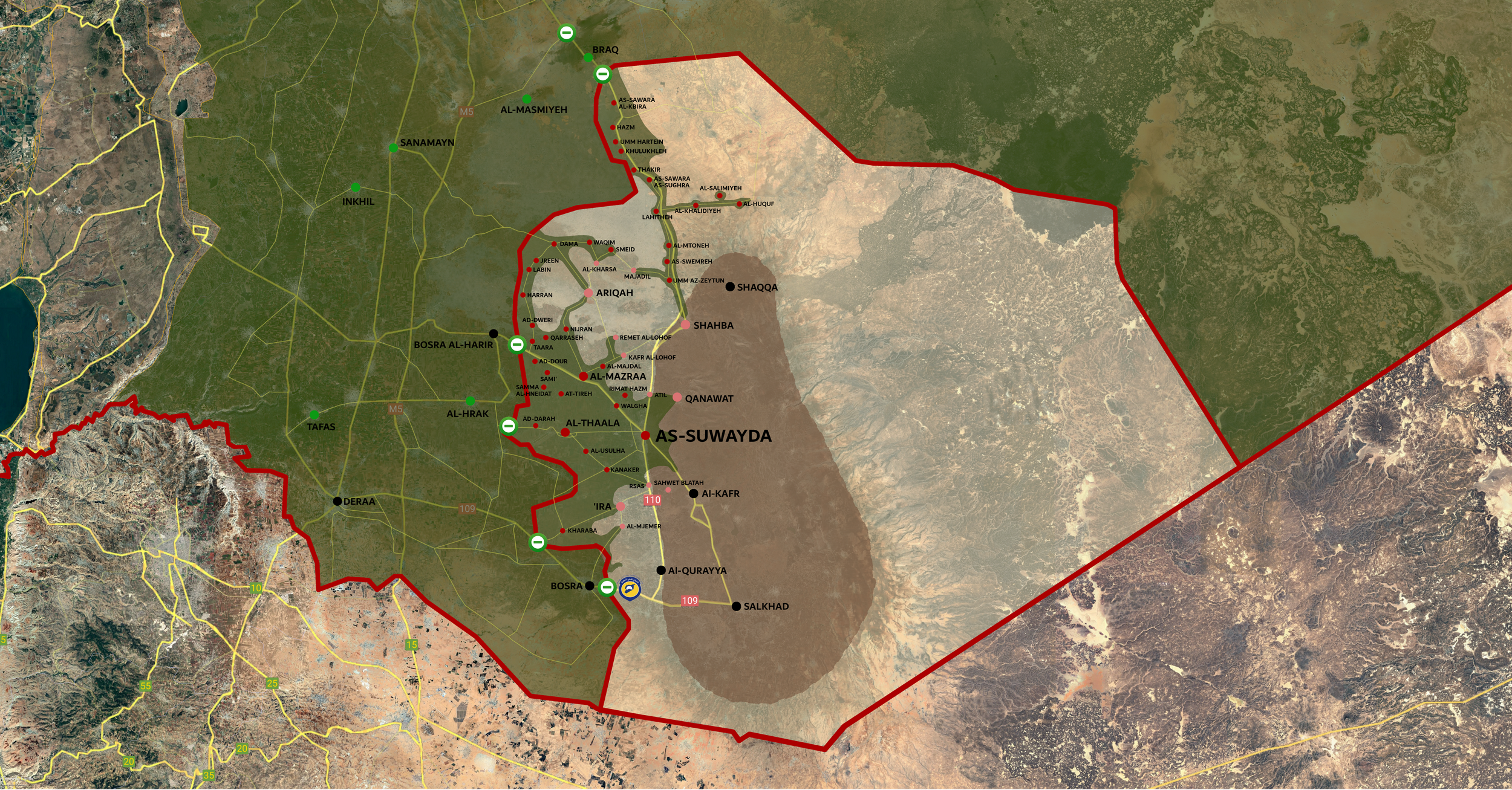
This work to of re-establishing the facts hour by hour since the beginning of the aggression against the communities of Suwayda was carried out on the basis of our own experience on the spot, the testimonies of our relatives and members of Suwayda’s civil society (which we refuse to qualify as “Druze” insofar as the community includes Christians, Bedouins and some Muslim families native to the region and non-Bedouins), as well as the rereading of all the Facebook posts of several local media objectively reporting the facts over the period from July 12 to 26, 2025:
- Al-Raased: ~220 publications
- Aram News: ~230 publications
- Suwayda24: ~170 publications
- Suwayda Media: ~100 publications
To these can be added the publications of the main players in the conflict:
- Gathering of the Southern Tribes (Tajmua Asha’er al-Janub): 332 publications
- Legion of the Mountain of Dignity (Liwa Jabal al-Karama – leader: Shakeeb Azzam): 49 publications
- Movement of the Men of Dignity (Harakat Rijal al-Karama – leader: Yahia al-Hajjar): 30 publications
- Sheikh Hikmat al-Hajari: 15 publications
- Army of Unitarians (Jaysh al-Muwahidun – leader: Osama al-Safadi): 9 publications
- Forces of the Sheikh of Dignity (Quwat Sheikh al-Karama – leader: Raafat Baali): 9 publications
- Suwayda Military Council (Majliss al-Askari fi as-Suwayda – leader: Tareq al-Shufi): 6 publications
- Madhafe of Dignity (Madhafet al-Karama – leader: Layth al-Balous): 5 publications
- Gathering of Free Men of the Arab Mountain (Tajmua al-Ahrar Jabal al-Arab – leader: Suleiman Abd al-Baqi): 1 publication
It is important to remember that it all began on the evening of July 11, 2025, with the kidnapping, theft (vehicle, 5 tons of fruit and vegetables, 7 million Syrian pounds, a phone) and the torture of Fadlallah Naeem Dwara, a merchant from al-Kharsa (Suwayda), near the Braq/al-Masmiyeh checkpoint.
It should be noted that this checkpoint controls the junction of the roads between Damascus, Suwayda, and Deraa and has been held since May by members of the Al-Naim tribe of Mteleh who do not officially answer to the orders of the Al-Sharaa regime. Several fighters controlling this checkpoint wore balaclavas and Islamist insignia (shahada and Islamic State flag).
Fadlallah Naeem Dwara was then thrown, shackled, onto the side of a road, from where he was able to reach Route 110 and be picked up by motorists, who took him to the hospital.
It should also be noted that the region between Braq and Mteleh is home to criminal groups that have been committing abuses and crimes against users of Route 110 between Suwayda and Damascus for many years, often in collaboration with the Bashar al-Assad regime. All indications are that these groups, as well as the unidentified armed men controlling the Braq/al-Masmiyeh checkpoint, are involved in the kidnapping of Fadlallah Naeem Dwara.
Saturday 12 July
(13 press publications)
15h to 22h
Fadlallah Naeem Dwara’s relatives responded to the attack by kidnapping two, then eight Bedouins from Suwayda tribal community and from Al-Hasakeh tribes with the help of a faction from Ariqa (bordering Al-Kharsa), demanding the return of Fadlallah Naeem Dwara’s truck in exchange.
The Suwayda electricity company announced the cutting of the high-voltage line supplying the governorate at Al-Kaswa and Sheikh Meskin.
Tensions and exchanges of fire took place in Shahba, in the Bedouin neighborhoods of Shaqrawiya and Mansoura, followed by attempts for mediation by the sheikhs of the different communities involved. A first casualty, Rami Faysal Naeem, was admitted to the Suwayda hospital after being shot in the head. The Southern Tribes Assembly announced a return to calm late in the evening.
Sunday 13 July
(75 press publications)
10 a.m. to 11 a.m.
Members of the Shanabla tribe of Al-Maqwas (associated with Syrian-Jordanian sheikh and businessman Rakan Al-Khudeir, leader of the Southern Tribes Gathering and notorious drug trafficker) kidnap five residents of Suwayda on the Suwayda-Damascus road.
11 a.m. to 12 p.m.
The intervention of sheikhs from the community (notably Youssef Jarbou’a) and mediation efforts to end the escalation remain unsuccessful, and armed clashes have begun in the district of Al-Maqwas, a predominantly Bedouin neighborhood on the outskirts of the city of Suwayda.
12 p.m.
Internal Security cuts the road between Suwayda and Damascus.
3 p.m. to 5 p.m.
Seven wounded people are treated at the Suwayda hospital after being brought in from Al-Maqwas, while the neighborhood is the scene of heavy weapons clashes (mortars and RPGs) between armed Bedouin groups and Druze factions. Clashes also take place in Al-Kharej.
Statement: Sheikh Hammoud al-Hennawi issues an initial statement calling for reasonable behavior and an end to tensions that are detrimental to social peace.
5 p.m. to 6 p.m.
The Ariqa faction announces its decision to release the Bedouins taken hostage following mediation by the sheikhs.
Six deaths are recorded at this stage by the hospital, while the residents of Al-Maqwas are trapped between the two sides of the conflict: children Yaman Muqlad and Zyad Mazen Dal.
6 p.m.
A seventh death is reported at Suwayda hospital, along with 32 wounded.
Sniper fire is reported in Atil.
The governor of Suwayda, Mustafa Bakur, calls for calm in a statement, along with the residents of Al-Maqwas.
8 p.m.
Tribal groups from outside Suwayda launch an attack from the Suwayda-Izraa road on the villages of At-Tira, Harran, Labin, and Jreen located on the western border of the governorate, while the villages of Mazraa and Sami’ are subjected to mortar fire.
An attack is also reported at the Internal Security checkpoint in El-Al-Araq, Al-Sawara al-Kbira, and Hazm. Clashes continue in the Bedouin neighborhoods of Al-Mashourb, Al-Harubi, and Mansoura.
Three residents of the villages of Um Rwaq and Maf’aleh are killed: Aamer Nassar Nassar, Imran Al-Aqbani, and Basel Najm Ghanem.
9 p.m. to 11 p.m.
Statement: Sheikh Hikmat al-Hajari issues a statement denouncing attempts to incite sedition.
A mortar shell hits the home of faction leader Suleiman Abd al-Baqi in Suwayda, injuring four of his men.
Three other people die at the Suwayda hospital: Hamoud Naseeb al-Arbid, 65, Jalal Ghassan Abu Ghazi, 21, and Walid Fouad Al-Ish’oush. Two residents of Al-Majdal are also killed in At-Tireh: Ehsan Ahmed al-Shater and Khaldoun Salman al-Shater.
Monday 14 July
(75 press publications)
1 a.m. to 2 a.m.
At this point, the governorate is completely under siege, while the Rijal Al-Karami movement liberates the village of At-Tireh. The group issues a statement denouncing the violation of the agreements signed with the government in May, which included a promise to restore security on this same road. It emphasizes the need for the community to ensure its own self-defense.
2 a.m. to 3 a.m.
Press release: Sheikh Youssef Jarbou’a’s mediation results in the release of the Suwayda hostages held by Bedouin tribes in exchange for the payment of a ransom.
The first images showing the abuses in At-Tireh are broadcast.
6 a.m. to 9 a.m.
Tribal groups from Dera’a relaunch their offensive at dawn against the villages of Taara, Al-Dour, Sami’ and Al-Dwira with heavy mortar fire and drones. They also approach the village of Kanaker.
11 a.m. to 4 p.m.
The Israeli air force intervenes in the skies over Suwayda, while the Ministry of Defense and the Ministry of the Interior announce the deployment of troops and heavy weapons to the borders of the governorate, claiming to be intervening to “end the clashes and restore security.” However, the army is doing nothing to prevent the tribal groups from advancing, taking advantage of their support to move forward along the Bosra al-Harrir–Taara and Oum Walad–Kanaker axes.
Violent clashes are taking place in Al-Mazraa, Al-Thaala, and Kanaker.
Hundreds of displaced persons are fleeing the combat zones, and reception centers have been opened in Salkhad and Shahba.
Videos are beginning to emerge on social media, posted by tribal groups. These videos reveal the involvement of Sheikh **** and foreign fighters.
Statement: Emir Hassan al-Atrash issues a statement declaring that he is in talks with the government and Druze spiritual leaders to find solutions to the conflict.
Statement: Sheikh Hikmat al-Hajari also issues a statement rejecting any presence of the government army in the region and calling for international protection.
Tribal groups fired numerous mortar rounds at nine villages and the city of Suwayda, while 200 wounded were reported at the Suwayda hospital. Druze factions announce the death of 22 of their fighters near Al-Thaala and Kanaker, bringing the total number of deaths to 64. Among the fighters is a comrade-in-arms of local revolutionary hero Khaldun Zein ed-Din, Baha Abdullah.
The Druze leadership, along with the Suwayda Medical Corps, call for an end to all violence.
4 p.m. to 7 p.m.
Tribal groups and the government’s army seize Labin, Harran, Al-Dour, Al-Mazraa, and Al-Mjemer. The occupied villages are subjected to systematic destruction and looting of homes.
At this stage, the Suwayda National Hospital has recorded 53 deaths, including women and children, and more than 200 wounded. Al-Hakma Hospital reports that it has received a total of 40 wounded, one of whom has died from his injuries: Asim al-Qontar.
The Israeli air force carried out a strike on the outskirts of Al-Mazraa.
7 p.m. to 8 p.m.
Sheikh Hikmat al-Hajari met with several sheikhs from Mayamas at his home in Qanawat. A drone carried out a strike on the city, causing minor material damage.
Statement: The Druze leadership calls for a ceasefire and the expulsion of the Islamist groups responsible for the attack.
11 p.m.
Four missiles strike the city of Suwayda.
Tuesday 15 July
(84 press publications)
5 a.m.
Attacks resume in the village of Kanaker.
8 a.m. to 10 a.m.
Statement: The Druze leadership declares its acceptance of the governement’s army entering the area and requests that it secure the governorate’s internal military and defense institutions, inviting the government to engage in dialogue and calling on Druze self-defense factions to cease resistance, cooperate with the army, and surrender their weapons.
Sheikh Hikmat al-Hajari joins this statement, despite his opposition to the Al-Sharaa government.
In the wake of this, the Ministry of Defense and the Ministry of the Interior announce their deployment in central Suwayda, as well as the imposition of a curfew until further notice. They call on residents not to allow fighters to use their homes to target government forces.
Photographs are published showing the deliberate burning of the Christian church in Al-Sawara Al-Kabira by Islamist groups and the government army, which stormed the village two days earlier.
10:00 a.m. to 11:00 a.m.
Statement: Sheikh Hikmat al-Hajari issues a new statement, retracting his previous statement, which he says he signed due to international pressure.
The director of Salkhad Hospital, Loui Al-Shufi, announces that the hospital has reached capacity after receiving more than 40 wounded.
11 a.m. to 12 p.m.
The government’s armed forces enter the city of Suwayda accompanied by hundreds of Islamist fighters, who undertake the systematic destruction and looting of the city’s shops and monuments. Under the pretext of disarming the factions, these groups enter residential buildings and begin the systematic massacre of civilians they encounter. Snipers take up positions in empty buildings and shoot at civilians trying to move around the streets, while the city is heavily bombed. Mortars are fired at the town of Atil, north of Suwayda.
12:00 p.m. to 1:00 p.m.
The Ministry of Defense declares its intention to transfer control of Suwayda to the forces of the Ministry of Interior and announces a ceasefire, promising to prosecute the perpetrators of crimes and offenses. Images are broadcast showing a military convoy including heavy weapons heading towards the exit of Suwayda, while a Military Police convoy is deployed in Suwayda.
1:00 p.m. to 3:00 p.m.
The commander of the internal security forces for Suwayda, Colonel Ahmed Dalati, and the commander of the internal security forces for Deraa, Colonel Shahir Imran, meet with community leaders in Suwayda to discuss the deployment of internal security forces.
Tribal groups nevertheless continue their war crimes and acts of genocide. Chaos reigns in the city and among the forces present, with social media spreading contradictory messages. Civilians are subjected to humiliation, abuse, and summary executions, while the shabiha of the new regime, Jamil Al-Hassan and Qutayba Yassin, posing as journalists, spread false information mixed with calls for sectarian hatred.
The first images of summary executions of civilians are broadcast, including those of the 13 members of the Al-Radwan family, shot at point-blank range in the living room (madhafeh) of their home, where they believed themselves to be safe: Wessam Fahad Radwan, Ashraf Fahad Radwan, Nasreen Radwan, Omar Muafagh Radwan, Imran Muafagh Radwan, Samer Moazi Radwan, Satea Reza Radwan, Rabee Radwan, Khaldoon Radwan, Khalid Radwan, Essam Radwan, Mamun Sabir Radwan, Majdi Mamun Radwan.
Crowds of civilians are trying to flee Suwayda towards the south.
4:00 p.m. to 5:00 p.m.
An Israeli strike targets a light vehicle belonging to the government’s army near the criminal police building, while Islamists have taken over the governorate headquarters and are advancing on the northeast axis toward the Khaldun Zein ed-Din roundabout and the Qanawat road. At the same time, they are advancing on the south-eastern axis towards the national hospital, where dozens of wounded people have gathered, while the response from Druze self-defense factions is strengthening on the north-western axis towards Walgha and the south-western axis towards Kanaker. Outside the city, violent clashes continue around ‘Ira and Al-Mjemer.
Medical sources in Suwayda report that Dr. Faten Hilal was shot dead by a sniper as she was on her way to the National Hospital to help the overworked staff, along with six members of the Qordab family at the Sultan Basha roundabout: Hisham Qordab, Fajr Qordab, Leith Qordab, Imran Qordab, Zaid Qordab, and Rebal Qordab.
5 p.m.
Regime forces and Islamist groups launch a raid on the national hospital compound.
7 p.m. to 8 p.m.
The director of medical teams at the national hospital, Dr. Omar Obaid, calls on the parties to the conflict to respect the hospital’s neutrality and allow it to operate normally.
Sources report the abduction of civilians by Islamist groups and government forces, while medical sources count more than 20 summary executions. The disappearance of a couple and their son is reported: Eman Naseeb, Nasir al-Hadwe, and Adam.
The government’s official armed forces are gradually withdrawing from the city of Suwayda.
10 p.m. to midnight
Images of the destruction of the Christian Church of As-Sawara Al-Kabira are broadcast as the village is occupied by the government’s armed forces.
Several villages in the region, as well as the city of Suwayda, are subjected to intense bombardment and their streets are the scene of intense clashes. The Salkhad hospital in the south of the governorate declares that it is reaching capacity due to the arrival of numerous injured people.
The Rijal al-Karami community self-defense movement has issued a statement holding the regime’s army responsible for the deaths of a large number of its fighters and accusing it of violating the ceasefire agreement signed prior to its entry into the city of Suwayda. It condemns the numerous abuses committed by the army and the Islamist groups accompanying it and reaffirms the right of the Suwayda community to self-defense.
Wednesday 16 July
(57 press publications)
1:30 p.m.
The media announces the death of Sheikh Marhaj Shaheen (80), originally from Al-Thaala, following the release of a video by tribal groups showing him being humiliated and his moustache shaved off.
Videos filmed by Islamists show trucks leaving Suwayda for Deraa loaded with furniture looted from homes in Al-Thaala.
9 a.m. to 12 p.m.
The city of Suwayda, as well as the villages of Rsas and Sahwet Blata, located 10 kilometers south of it, are subjected to intense mortar bombardment from dawn. Other villages are targeted by Grad rocket fire, while tribal groups invade houses near the junction between the Rsas and Kanaker roads (south of Suwayda). Three residents are kidnapped and then executed: Muhammad al-Barbour, Ra’ed al-Barbour, and Amjad al-Barbour.
Entire families are killed in Sami’, Al-Mazraa, and several other villages after their homes are raided by tribal groups claiming to be members of the General Security.
The area surrounding Suwayda Hospital is the scene of clashes and the target of mortar and RPG fire, while a tank advances toward the building and blocks access to ambulances. Snipers from the government’s armed forces take up positions in the hospital bunker and fire on civilians attempting to receive medical care there. At the end of the clashes, hospital staff declare that the hospital is out of service and blocked by heavy weapons, requesting that patients be transferred to other medical facilities in the province.
The execution by a sniper of Dr. Talaat Fawzi Amer, famous for his participation in the Syrian revolution against Bashar al-Assad, is announced. Medical staff confirmed that all the injuries treated at the hospital were the result of gunshots to the head, including women and children. Reports of crimes and summary executions are multiplying, with the city of Suwayda being invaded by tribal groups who are randomly killing residents in front of their homes, breaking into houses, looting them, and setting them on fire.
12:00 p.m. to 2:00 p.m.
Statement: The Rijal al-Karama movement issues a statement paying tribute to its martyred fighters and condemning the aggression by government forces, recalling that the Druze factions have not stopped calling for a ceasefire.
The hospital is heavily bombed, while its staff is trapped inside. Armed men move through the Qalaa and Nahdha neighborhoods, shooting at homes and attacking residents in their homes.
Citizen Abdullah Al-Baeini is executed in front of his family during a raid on his home.
A demonstration in support of Suwayda is organized in Aleppo.
2:00 p.m. to 4:00 p.m.
The media announces the death of the girl Tala Hussam Al-Shufi, killed by a sniper shot to the head. Her father, Hussam al-Shufi, is also known for his support of the Syrian revolution against Bashar al-Assad.
The Israeli air force is concentrating its strikes on the area around the village of Kanaker, located 8 kilometers southwest of Suwayda, against locations firing mortars at the city.
Numerous accounts are piling up, testifying to large numbers of residents trapped in their homes, hiding in basements, or summarily executed in several neighborhoods of the city of Suwayda by tribal groups as well as by fighters wearing the uniform of the government’s army. Members of the government’s army broke into the hospital and executed two civilian volunteers and several wounded patients. Summary executions of civilians are also reported in the town of Shahba, located 17 kilometers north of Suwayda, along the road to Damascus. Four people are executed in the village of As-Sawara as-Sughra: Mazen Obaid, Zia’ Obaid, Aseel Kamel Obaid, and Abdullah al-Khatib.
The regime’s armed forces and accompanying tribal groups are moving up the road from Suwayda towards Qanawat, the home of Sheikh Hikmat al-Hajari, and violent clashes are taking place at the National Museum.
A truck loaded with looted furniture is hit by Israeli air strikes as it prepares to leave Suwayda for Deraa.
The governorate remains under siege, with no way out, no electricity, no ADSL, and no telephone lines, while the mobile network is extremely unstable.
Many civilians are heading toward the Jordanian border to escape the fighting and abuses.
4 p.m. to 6 p.m.
Israeli strikes hit the presidential palace and the Ministry of Defense in Damascus. This unnecessary show of force only serves to turn the entire Syrian population against the Suwayda community.
The death toll stands at more than 300 civilians and combatants.
Mass mobilization of Druze combatants to liberate the city of Suwayda from tribal groups.
A group of protesters gathers in front of the Parliament building in Damascus to protest against the military operation in Suwayda.
6 p.m.
The town of Al-Kafr, located 11 kilometers southeast of Suwayda, is targeted by bombing.
Statement: Sheikh Hikmat al-Hajari declares that no agreement has been reached with the government, demands the unconditional withdrawal of all armed forces that have invaded the region, and calls for the continued armed defense of the community.
The villages west of Suwayda continue to be systematically looted and their property transferred by tribal groups to Deraa.
Thousands of displaced persons are heading south, while all roads leading out of the Suwayda governorate remain blocked. The national hospital is virtually out of service and corpses are piling up in the streets, while large areas are without electricity and suffering from water shortages. Communication networks are virtually non-existent.
9 p.m.
The US Secretary of State calls on the Syrian government to withdraw its armed forces from Suwayda. Once again, this does not apply to tribal groups that support the government’s army.
Statement: The Rijal al-Karami movement issues a statement declaring that it will not accept any agreement that does not include the total withdrawal of all armed forces committing war crimes in the governorate, and that it will fight to the last combatant until the invaders withdraw from the towns and villages they have occupied.
11 p.m. to midnight
The Ministry of Defense announces the start of the withdrawal of its armed forces. This decision still does not apply to tribal groups that remain in many neighborhoods, particularly in Al-Khudher, Nazla al-Auj, near the Cultural Center, near the al-Omran and al-Zinabqa roundabouts, etc. The national hospital also remains under siege.
Thrusday 17 July
(53 press publications)
Midnight to 1 a.m.
A video confirms the summary execution of a group of civilians near Teshrin Square (recently renamed “Martyr Khaldoun Zein Eddin Square” in honor of a Druze defector from the army who formed a Free Syrian Army battalion against Bashar al-Assad in 2012).
A group of Islamist fighters is captured in Suwayda, including two foreign fighters.
Numerous eyewitness accounts confirm the presence of many bodies in the streets of Suwayda.
The regime’s armed forces begin to withdraw, while tribal groups remain in the city of Suwayda.
6 a.m. to 11 a.m.
After the regime’s armed forces withdrew, Druze factions gradually regained control of the city and discovered the extent of the destruction and crimes committed. Numerous bodies littered the streets of the city and filled the rooms and corridors of the hospital. A large number of businesses were looted, destroyed, and burned.
It takes four hours to collect the bodies from the streets.
11 a.m. to 1 p.m.
Statement: Sheikh Hikmat al-Hajari issues a new statement calling for support for the families of victims and medical teams, and for the crimes to be documented. He also calls for the opening of a crossing point with Jordan.
Images of the massacres begin to be broadcast.
1:00 p.m. to 4:00 p.m.
The national hospital reports receiving 226 bodies, some of which are awaiting identification, and estimates that the total number of victims is likely to exceed 500, most of whom are civilians.
The bodies of 12 members of the same family, the Al-Muz’har family, are found in their apartment in the al-Koum neighborhood, including eight women and girls and an elderly disabled man.
Several bodies belonging to members of the Saraya family are discovered in Teshrin Square.
In several locations throughout the city, bodies of civilians are found in their vehicles riddled with bullets.
Statement: Sheikh Youssef Jarbou’a issued a statement denouncing a massacre organized under the guise of a “simple security operation,” contrary to the precepts of Islam, for which the Syrian state and the countries that support it bear full responsibility. He called on humanitarian organizations and international institutions to investigate and document the crimes.
False information and threats are being spread from phones stolen from the victims, and an intense disinformation campaign is being launched on social media and by mainstream media outlets, including Al-Jazeera, Al-Arabi, Al-Akhbariya, and SyriaTV. The Druze are accused of massacring hundreds of Bedouins, presenting the Druze victims as Bedouins and stirring up a wave of resentment and sectarian hatred on social media and across the country.
Most fake news stories are refuted by the website Verify.sy.
Statement: Sheikh Hikmat al-Hajari issues a statement rejecting all violence and calling for the Bedouin population not to be persecuted.
An armed group attacks the village of Walgha.
5 p.m. to 8 p.m.
Videos are circulating showing that Bedouin populations are being welcomed and sheltered in several public buildings in the region, notably in Shahba, Reemt al-Lohof, and Al-Kafr. Rumors are beginning to circulate on social media that these populations are being held hostage.
Friday 18 July
(51 press publications)
1 a.m. to 6 a.m.
Videos show houses on fire in Al-Mazraa.
A wave of fake news reports announced the invasion of Suwayda by Bedouin tribes, but the entry of armed groups has only been confirmed in Thakir and Walgha. False videos alleging crimes committed by Druze factions are circulating on the internet, some of which originate from massacres committed by Israel in Gaza.
Despite the rumors, Druze factions remain in control of most of the province, with the exception of some 20 towns and villages in the west and north.
8 a.m.
At this stage, thousands of Islamist militants across the country are declaring their intention to wage jihad against the Druze, while a number of villages in the west of the governorate remain occupied by the groups responsible for the crimes committed over the past four days.
The regime refuses to send its army back to Suwayda, while Turkey and Saudi Arabia declare their support for it.
12 p.m. to 2 p.m.
Statement: Father Tony Petros, representative of the Roman Catholic Church in Suwayda, calls for reason and peaceful coexistence.
The Druze factions announce the liberation of Suwayda, then Walgha, and the escape of the Islamists to Al-Mazraa.
3:00 p.m. to 4:00 p.m.
Press release: The Archdiocese of the Roman Orthodox Church of Bosra Hauran and Jabal Arab, represented by Archpriest Antonius Saad, calls for the reopening of roads and an end to the siege that is depriving 300,000 households of water, electricity, medicine, and food.
A new video shows the humiliation of a Red Crescent employee by a member of the tribal groups, who shaves his moustache in front of the camera, as well as the summary execution of medical staff at the national hospital.
5:00 p.m. to 6:00 p.m.
Nearly 80,000 families have been displaced from Suwayda by the violence towards the south of the province and the Jordanian border, while a thousand Bedouin families have been displaced to Deraa.
The hospitals in Suwayda are out of service.
An armed convoy of tribal groups is positioned near Barek coming from the desert, while hundreds of displaced people have taken refuge there in recent hours. They are unable to advance and are content to film the burning of houses left empty by their owners.
The military commander of Rijal al-Karama, Sheikh Abu Dyab, has released a video showing his men liberating Walgha.
6 p.m. to 8 p.m.
The village of Sahwet Blata announces the death of 19 of its residents, killed in a massacre committed while the armed forces of the Ministry of Defense and the Ministry of the Interior were occupying the town. Most of the victims belong to the Al-Bani and Salah families.
The media outlet Al-Raased disputes the Civil Defense’s statement claiming that their employee, who had been missing since Wednesday, July 16, at 6 p.m. at the Al-Omran roundabout, had been kidnapped by Druze factions. It points out that the area was under the control of the government’s armed forces at the time and until late into the night.
10 p.m. to 11 p.m.
Druze factions announce the liberation of the village of ‘Ira, Al-Thaala, and Kafr al-Lohof, where many houses have been looted and burned.
Israel carries out airstrikes on armed groups remaining in the west of the province.
A video is released showing the execution by defenestration of three young men in Suwayda, forced to jump from a balcony by Islamists.
Saturday 19 July
(60 press publications)
1 a.m. to 6 a.m.
The Ministry of the Interior announces a ban on all vehicles and weapons entering Suwayda until further notice and calls on the Bedouin tribal command to withdraw their fighters from Suwayda and surrender their heavy weapons.
The White House envoy announces a ceasefire agreement between Israel and Syria, also signed by Turkey, Jordan, and their neighbors. The Jordanian army deploys on the Syrian border.
Factions continue to respond to attacks by tribal groups in the province.
Statement: Sheikh Hikmat al-Hajari confirms the deployment of government internal security forces around the province to prevent the entry of armed groups, prohibits anyone from entering border villages for 48 hours to avoid any initiative that could jeopardize the ceasefire, guarantees protection for Bedouin populations wishing to leave the province, declares the opening of a humanitarian passage to Bosra al-Harir (Deraa) and calls on civil society and armed factions to show responsibility and coordination.
11 a.m. to 2 p.m.
Statement: The Rijal al-Karama movement declares that “government-backed terrorists” continue to attack the province despite the ceasefire, continuing their criminal actions against the civilian population.
2:00 p.m. to 4:00 p.m.
Tribal groups continue to carry out attacks on several roads leading to Suwayda, in violation of the ceasefire agreements. A video is circulating showing these groups rejecting the ceasefire agreement.
The bodies of tribal fighters found in the streets are carrying military ID cards proving their affiliation with the Ministry of Defense.
The bodies of around 20 members of Mazhar family, including women and children, are discovered in their home in Suwayda.
Statement: The Archbishop of the Roman Orthodox Church of Bosra Hauran sends a message to the international community calling for immediate intervention to put an end to the barbaric massacres targeting young people and the elderly alike.
5 p.m. to 7 p.m.
The medical staff at Suwayda National Hospital declare that the healthcare system has collapsed and that it is impossible to remove the bodies stored within the hospital grounds, as well as reporting the deaths of patients due to the inability to provide them with adequate treatment.
Druze factions liberate the village of Al-Majdal.
7 p.m. to 9 p.m.
Factions continue to clash with disparate armed groups in certain neighborhoods of Suwayda.
Armed groups attack the towns of Ariqa from Dama, Kafr al-Lohof and Um Zeitun using mortars, heavy weapons and drones, while many residents are still there. The town of Shahba is also under attack.
Statement: Sheikh Hikmat al-Hajari confirms that the armed action of the Druze factions has been in response to the imperative of self-defense from the outset and that it is the adversary who is not respecting the ceasefire agreement, with armed gangs continuing to commit crimes against humanity. He calls on the countries that signed the ceasefire to take responsibility and protect the Druze community.
9 p.m. to 11 p.m.
Press release: The Southern Clans Assembly (Bedouins), led by Sheikh Nawaf al-Bashir, declares that reports of the beheading of Bedouin children are false, calls for the total and immediate withdrawal of all Bedouin fighters, reaffirms peaceful coexistence with the Druze, and calls for reason and dialogue.
Statement: The Patriarch of the Roman Orthodox Church of Antioch and the Levant calls for an end to the massacres that are jeopardizing coexistence between communities.
A video is circulating showing “journalists” participating in the destruction of Druze religious symbols inside private homes.
Sky News reports testify to the systematic looting of homes by Islamist groups and the massive transfer of stolen goods to the province of Deraa.
Tribal groups attack Shahba after entering Um Zeitun.
Dimanche 20 Juillet
(52 publications de presse)
10h à 11h
Les factions druzes continuent de résister aux attaques des groupes tribaux au Nord de Shahba et Ariqa, tandis que le pillage et l’incendie des maisons se poursuit dans les villages occupés par les forces armées du régime.
Une vidéo atteste de la mise à l’abris des familles bédouines au centre d’accueil temporaire de Shahba.
12h à 14h
Des vidéos montrant les familles bédouines accueillies et prises en charge dans des centres d’accueil sont diffusées par la communauté druze pour démentir les rumeurs selon lesquelles ces familles seraient prises en otages et maltraitées.
Un premier convoi humanitaire du Croissant Rouge entre à Suwayda.
Communiqué : le sheikh Hikmat al-Hajari exige la fin des actions armées et le retrait de toute les forces armées affiliées au régime, accueille l’entrée de l’aide humanitaire dans la province et appelle à la fin immédiate des attaques haineuses contre la communauté, ainsi que les campagnes médiatiques mensongères visant à attiser la haine. Il demande aussi le rétablissement des lignes électriques et des communications et la libération des prisonniers et otage, qui doivent être livrés à 18h sur la place du village de Um Zeitun.
14h à 17h
Des images témoignent de la destruction totale des hangars de stockage du Croissant Rouge à Suwayda.
Communiqué : L’ONU établit une liste des besoins urgents pour Suwayda, à savoir l’ouverture d’un passage sécurisé pour les civils, l’entrée d’aide médicale, d’eau et de nourriture ainsi que l’accès sécurisé et la protection des travailleurs humanitaires.
Publication d’une liste de 25 résidents de Suwayda pris en charge à l’hôpital de Deraa.
17h à 22h
Les factions annoncent la libération complète de Um Zeitun, tandis que Ariqa continue de résister aux attaques des groupes tribaux. Des échanges de tirs ont lieu à Reemat Hazm.
17 femmes de Suwayda sont rappatriées saines et sauves vers Jaramana depuis Deraa.
Des images témoignent des nombreuses violations, destructions et pillages d’habitations commis par les groupes tribaux et les forces gouvernementales dans les villages de Kanaker et Mazraa.
22h à minuit
Les sources médicales annoncent que plus de 600 corps ont été amenés à l’hôpital national depuis le début des massacres, indiquant que cela ne prend pas en compte les corps emmenés aux hôpitaux de Salkhad, Shahba et Sali, ainsi que les corps enterrés sans avoir été emmenés à l’hôpital et les nombreux corps toujours parsemés dans les rues.
Monday 21 July
(33 press publications)
11 a.m. to 1 p.m.
Druze factions continue to resist attacks by tribal groups in Shahba and Um Zeitun, which are making extensive use of drones. This is the thirteenth time that tribal groups have violated the ceasefire agreement.
Druze factions manage to stop attacks on the village of Ariqa from the three axes of Dama, Najran, and Harran.
The US special envoy declares that the Syrian regime must be held accountable.
1:00 p.m. to 3:00 p.m.
The transfer of bodies from the Suwayda National Hospital for burial has begun with the help of the Red Crescent. All bodies have been photographed in advance in accordance with legal procedures.
A list of 25 patients from Suwayda being treated at Al-Razi Hospital in Damascus is made public to reassure their relatives.
3 p.m. to 7 p.m.
New mortar fire hits the town of Ariqa.
Christian churches in the region open their doors to serve as emergency medical centers and provide vehicles to serve as ambulances.
Many volunteers participate in cleaning up the Suwayda National Hospital.
The Al-Mazraa hospital announces that it is once again operational.
The Suwayda Bar Association announces its collective resignation in protest against the denial of terrorist crimes and massacres committed in the province.
Students from Suwayda residing in other governorates are being threatened on social media by Islamists, who are publishing their photographs and addresses.
Armed men attack the village of Hayat.
7 p.m. to 8 p.m.
Press release: The Rijal al-Karama movement disputes the false information spread by media outlets complicit in the massacres, claiming that Laith al-Balous is their leader, pointing out that he has been leading his own movement since 2016. It points out that in the face of the aggression against the community, all components of the mountain form a united bloc.
Evidence of a new massacre of civilians by the forces of the Ministry of Defense and the Ministry of the Interior is emerging: engineer Samir Hussein Hamidan was found murdered in his home in his wheelchair, along with two members of his family.
A group of lawyers is preparing a legal case establishing the responsibility of the Director of Security for Suwayda, Colonel Ahmed Haytham Dalati, and the Director of Security for Deraa, Colonel Shahir Jabbar Imran, in the commission of war crimes.
8 p.m. to 9 p.m.
Tribal groups continue their attacks on the village of Um Zeitun and the town of Shahba, targeting wheat and flour reserves in a clear attempt to facilitate the siege imposed by the regime. The youth of Majadil put up fierce resistance to the tribal groups and call for reinforcements.
A video taken from CCTV footage in a shop in Suwayda confirms that members of the government armed forces played an active role in the massacres of civilians on July 15 and 16: a sheikh is shot dead at point-blank range in the street by men wearing General Security uniforms while walking unarmed in the street. Other videos show raids on private homes and violent attacks on residents.
There are also increasing reports of summary executions, implicating both tribal groups and government forces.
10 p.m. to midnight
As calm seems to be returning, more than twenty villages have been completely destroyed and burned down.
The Rijal al-Karama movement has announced the death of 46 of its fighters since the attacks began.
A first convoy of tanker trucks carrying fuel and gasoline entered Suwayda from Bosra al-Sham toward the town of Al-Qurayya.
Tuesday 22 July
(41 press publications)
9 a.m. to 12 p.m.
The population of more than 30 villages in Suwayda has been evacuated and displaced due to attacks by government forces and their tribal auxiliaries.
Employees of the Suwayda electricity company attempting to restore power to lines near Kanakr warn of the presence of snipers. The company reports that it has lost numerous vehicles and seven of its best employees in the massacres.
Filmed testimonies from victims of the attacks are multiplying, while a new surveillance video shows members of government forces engaging in the destruction and looting of businesses during their temporary occupation of Suwayda on July 15 and 16.
12:00 p.m. to 3:00 p.m.
Statement: Sheikh Hikmat al-Hajari calls for restrictions on the sharing of sectarian and provocative publications and speeches, while reminding people that the Bedouins are part of the community, should not be persecuted, and must be protected.
Videos and photographs show the destruction of property and homes in the village of Najran.
5 p.m. to 6 p.m.
The effects of the 10-day siege of the province by government forces are beginning to seriously impact the population, which is lacking water due to a total power outage preventing pumps from operating to retrieve water from wells. At the same time, numerous fires are mobilizing tanker trucks to enable firefighters to extinguish the blazes.
9 p.m. to 11 p.m.
Press release: The archbishop of the Roman Orthodox Church of Bosra Hauran and the Arab Mountain denounces false reports claiming that Christians are being expelled from the province and reiterates that Christians are defending their land and heritage while providing protection and spiritual and community support to the population.
A new video has been released showing the summary execution of Al-Thaala resident Mounir Al-Rajma by members of the government forces when he declared himself to be Syrian after they asked him if he was Druze.
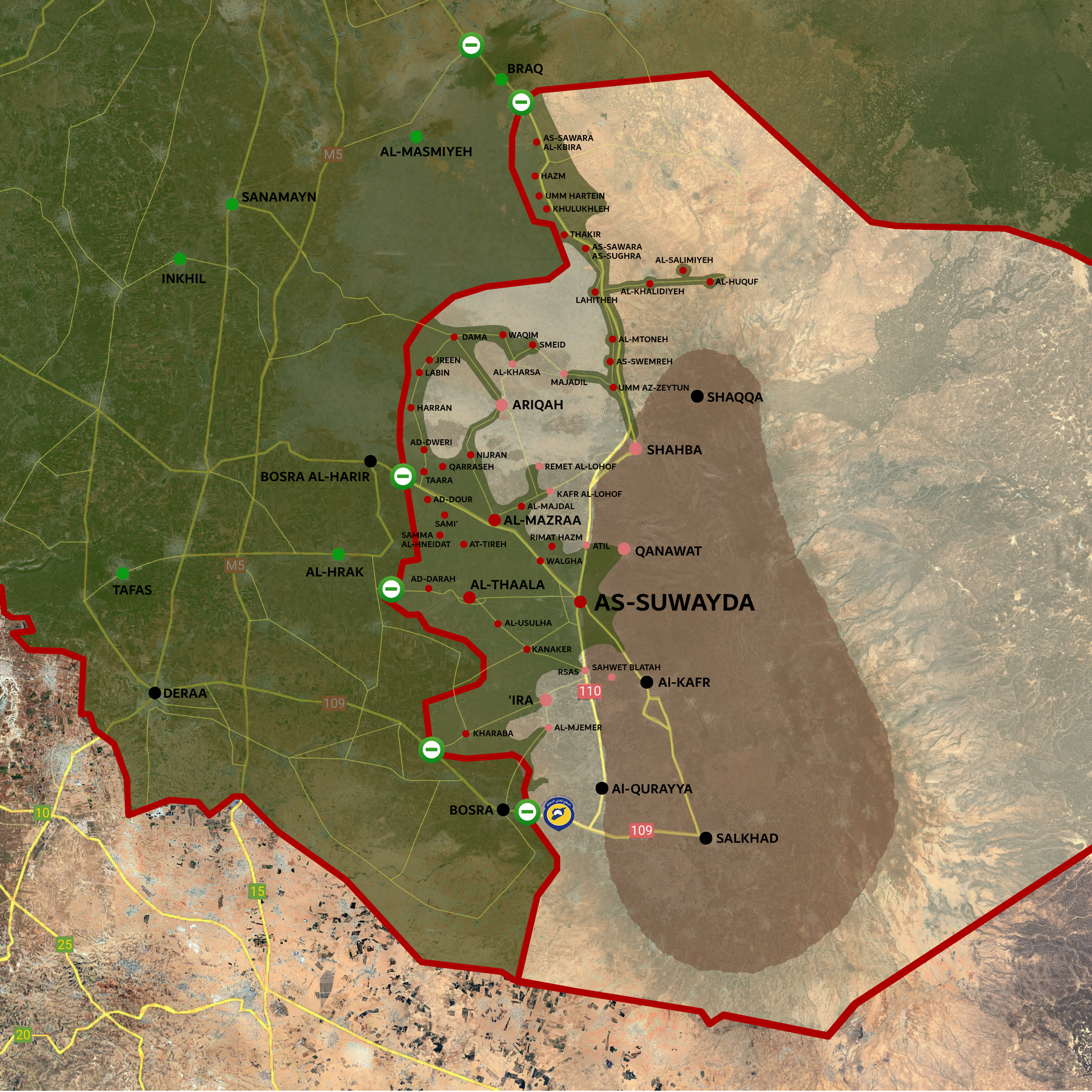
LEGENDE:
- Green – Area under regime’s control before 22 of July.
- Brown – Mountain “Jabal al-Arab”
- Red dots – Towns under control of the regime (30 of them entirely destroyed)
- Pink dots – Towns attacked but not occupied.
- Green dots – Main cities in Deraa from which the tribes departed.
